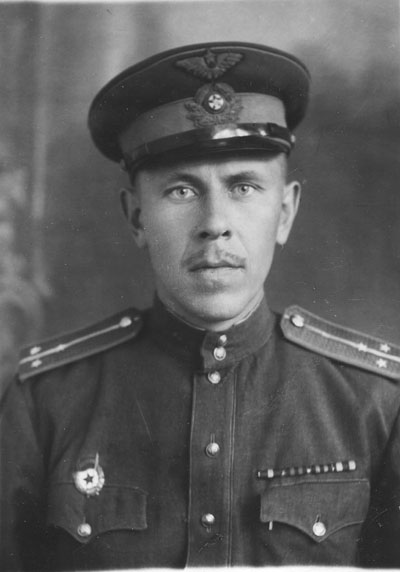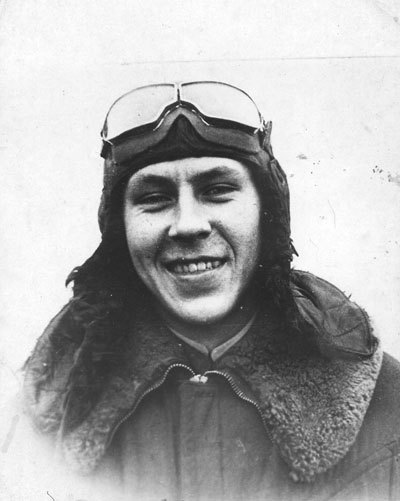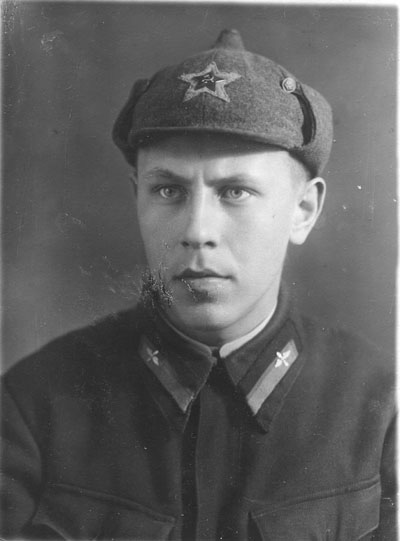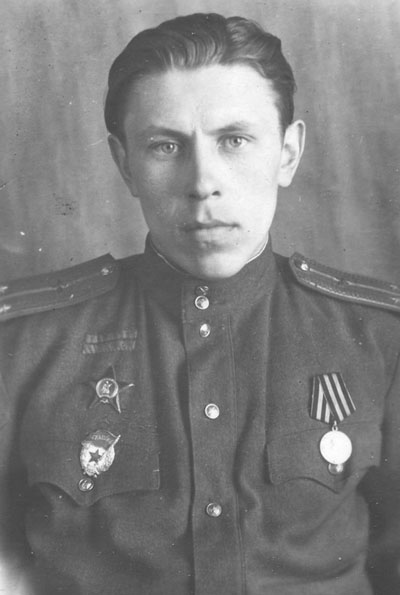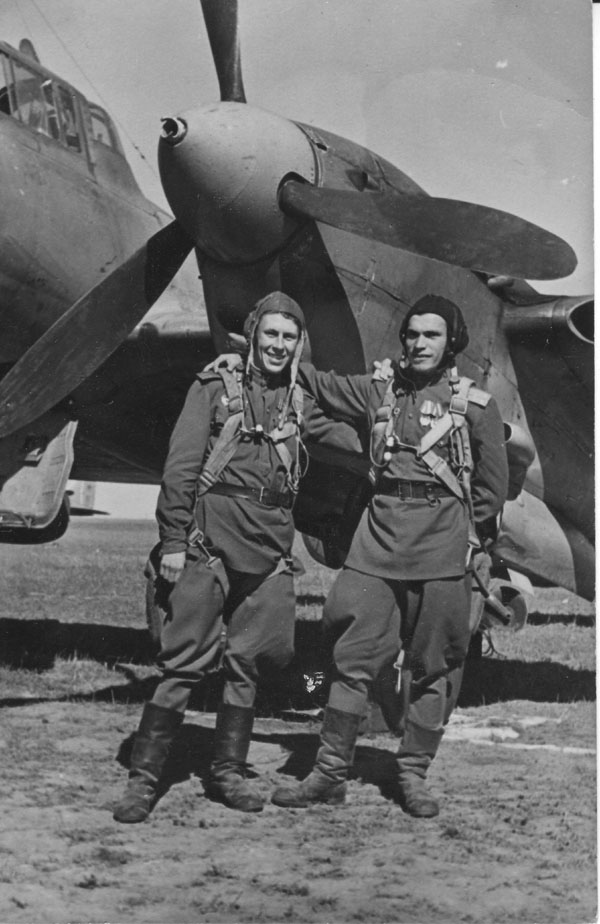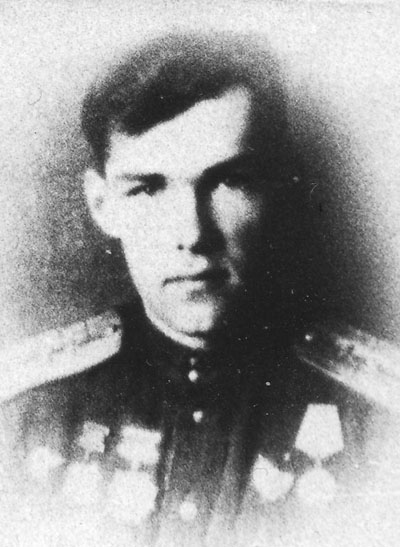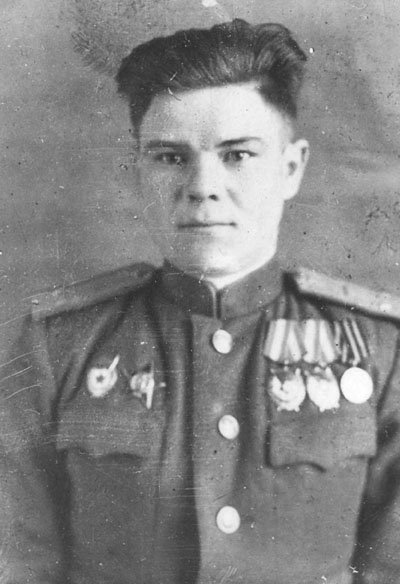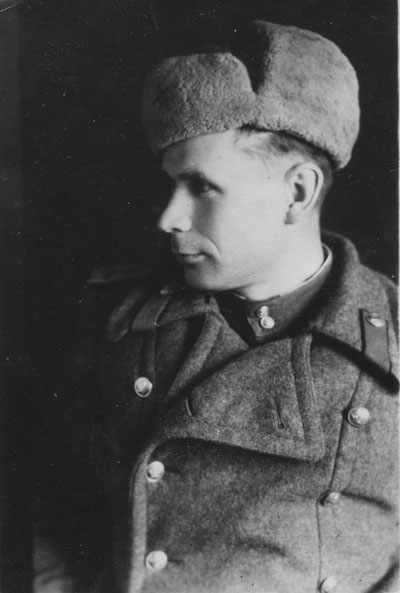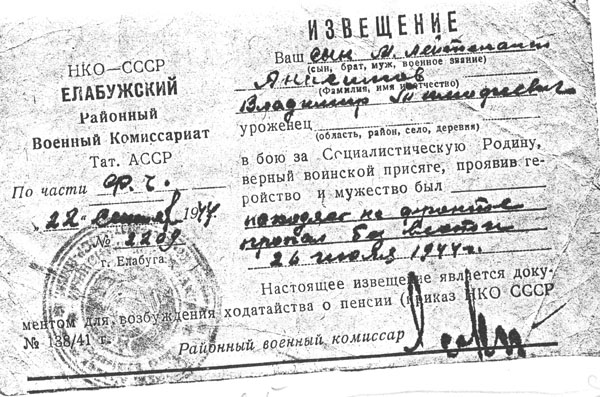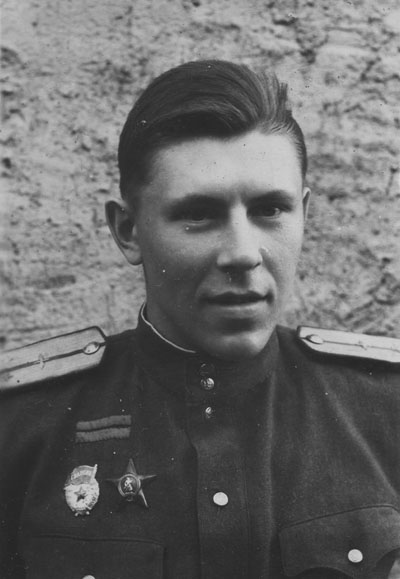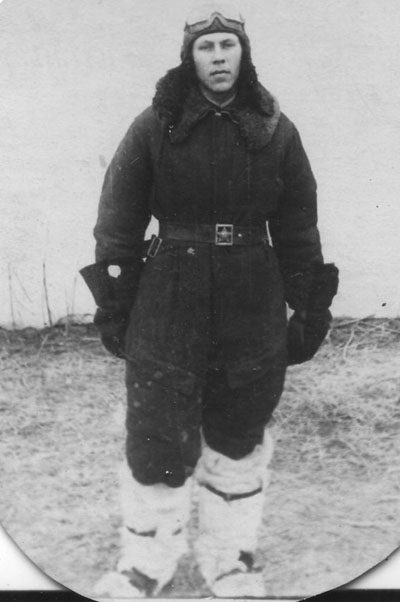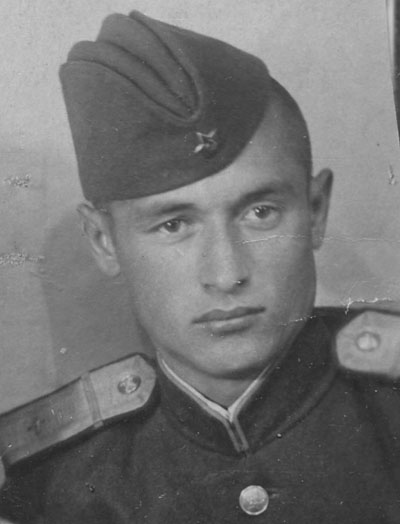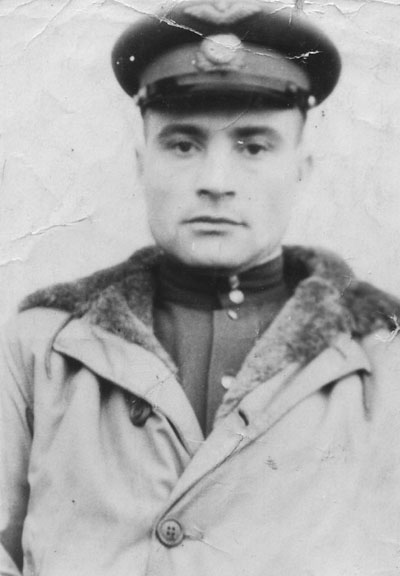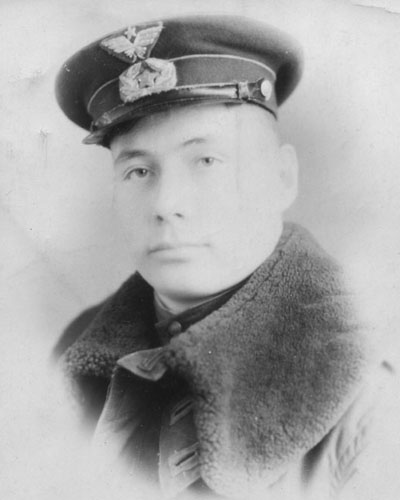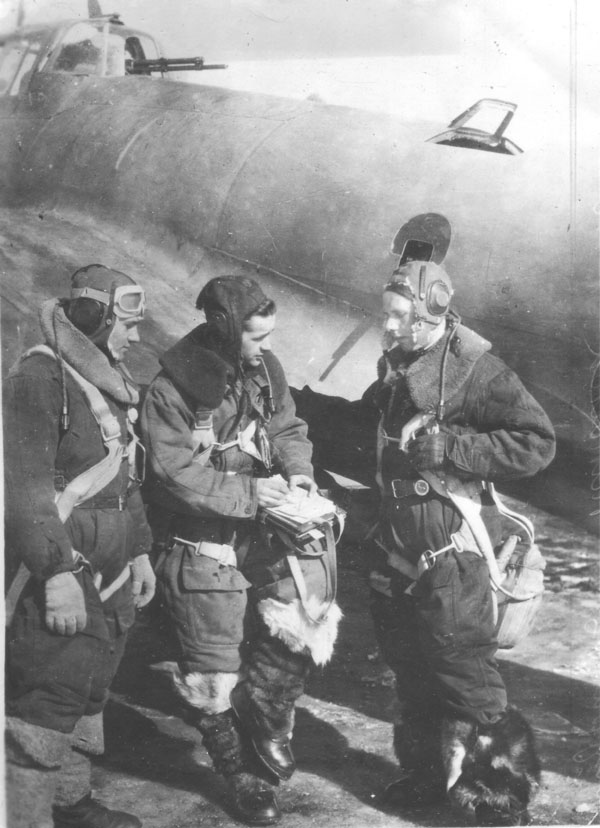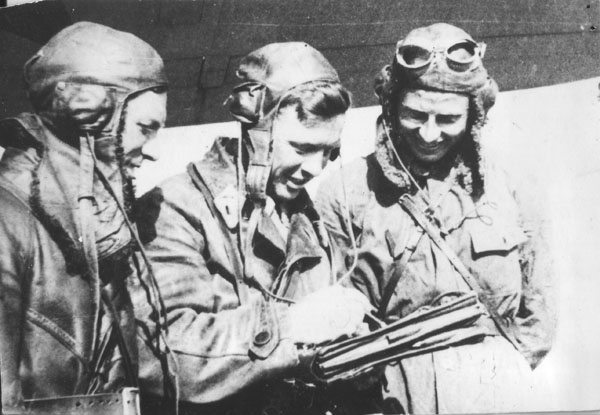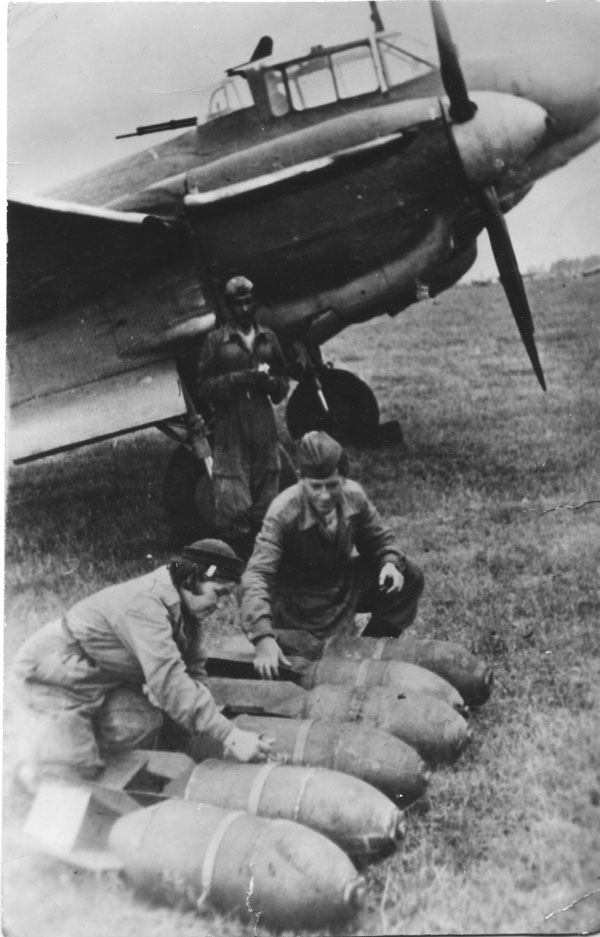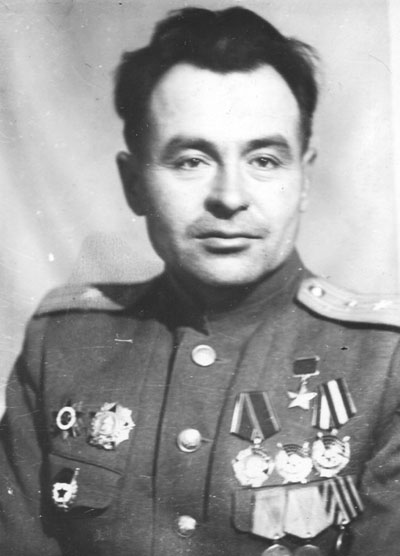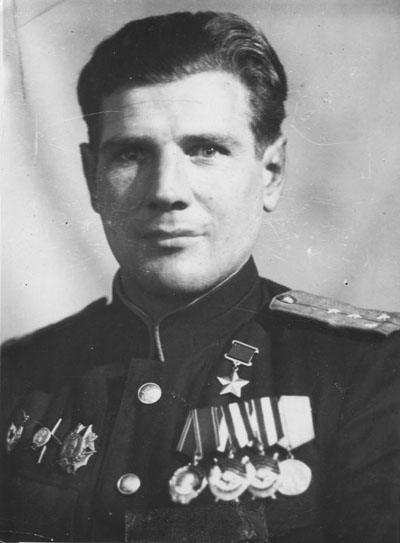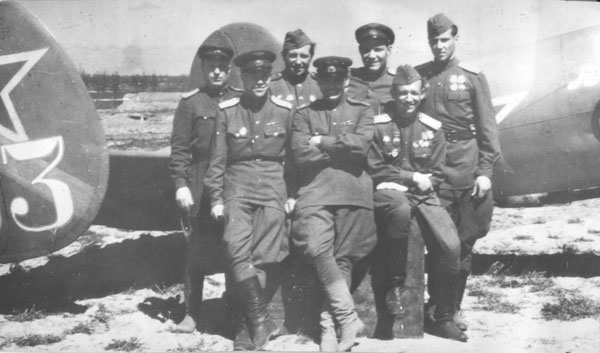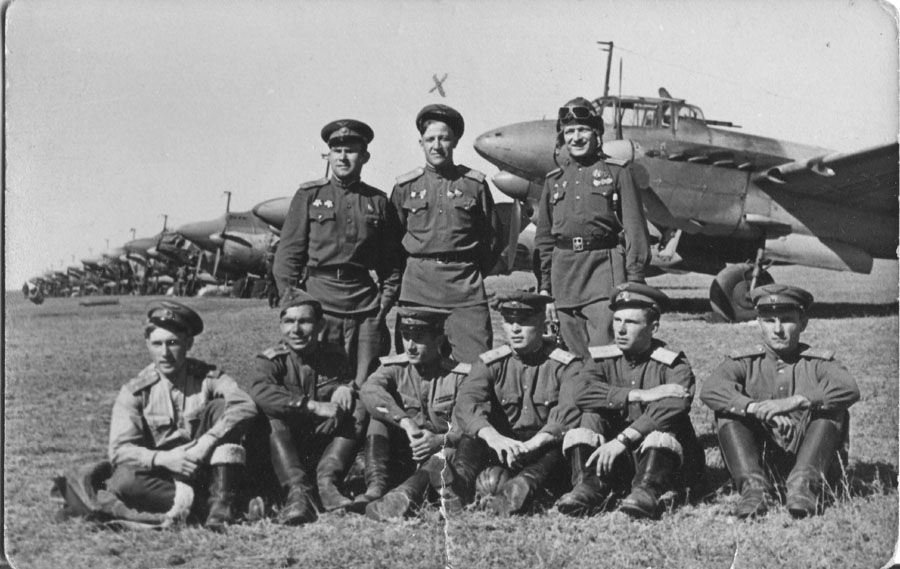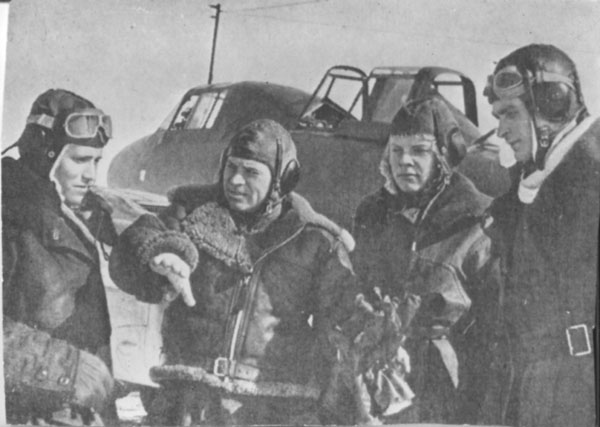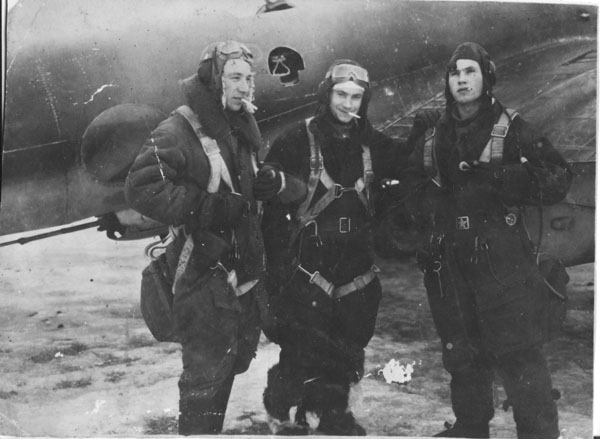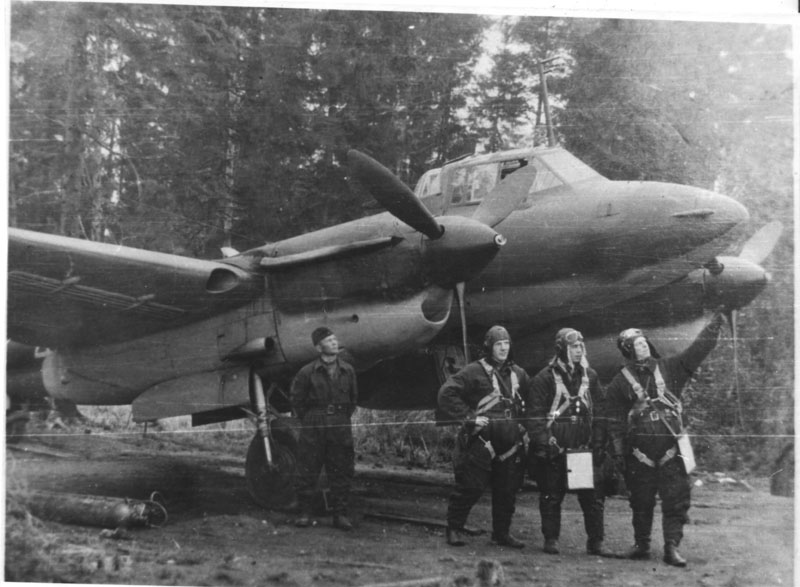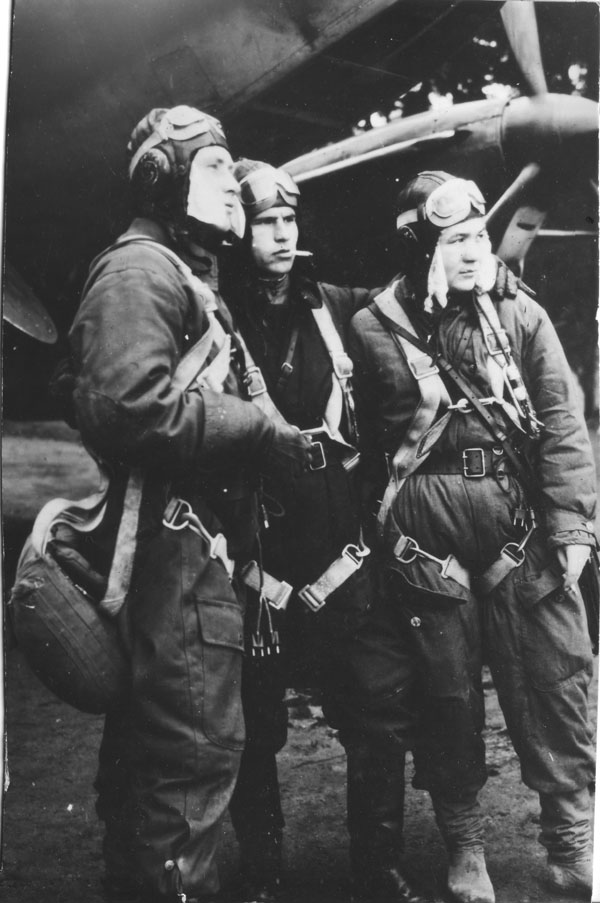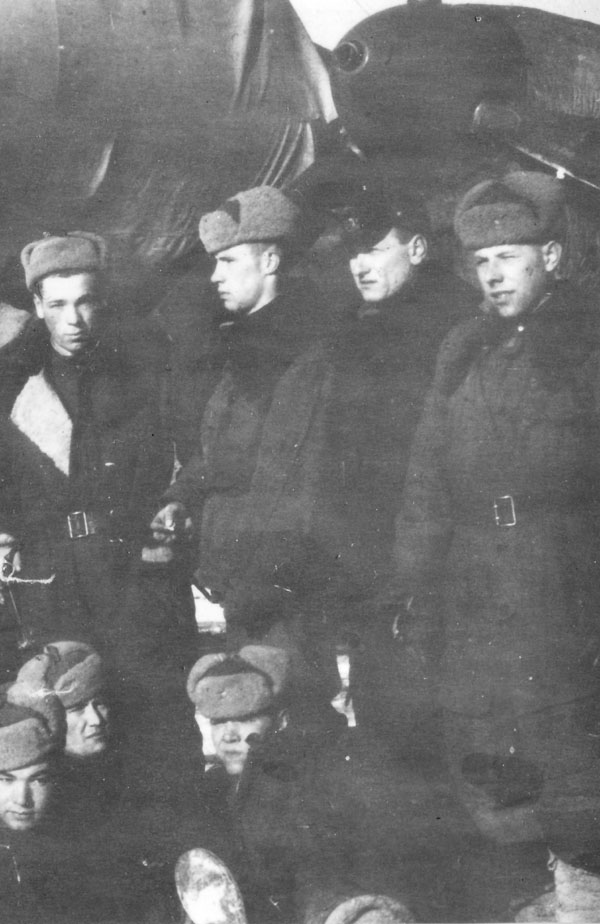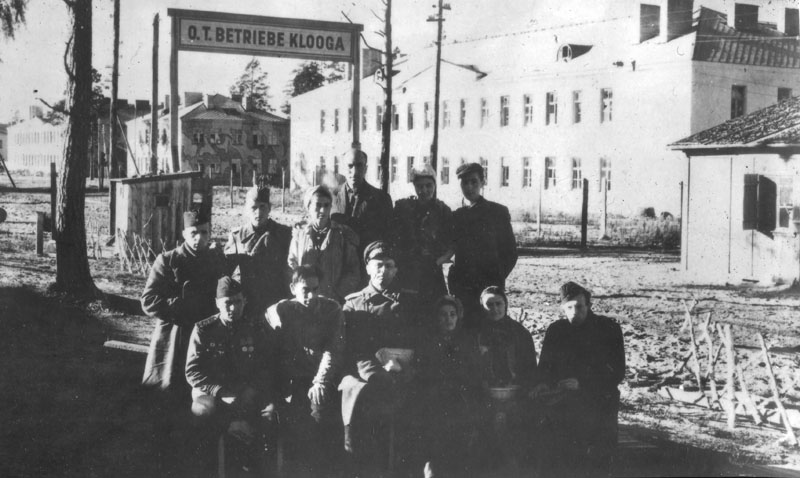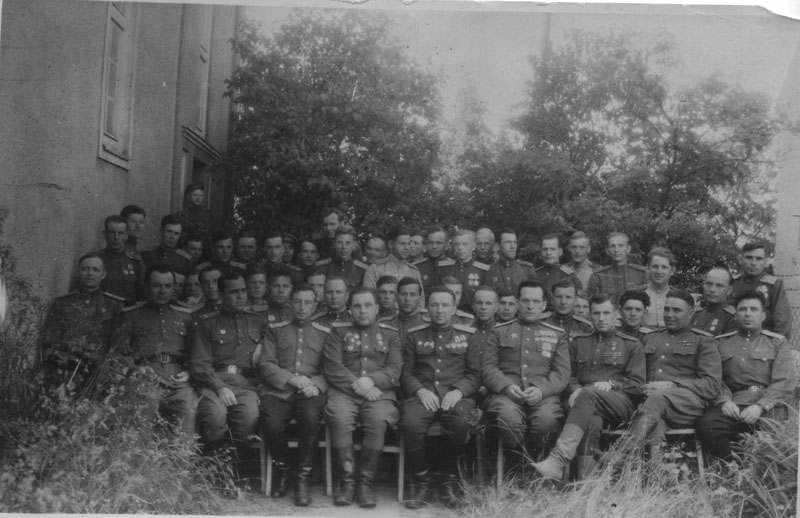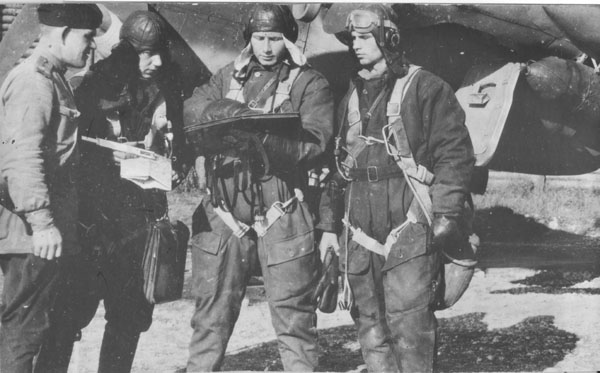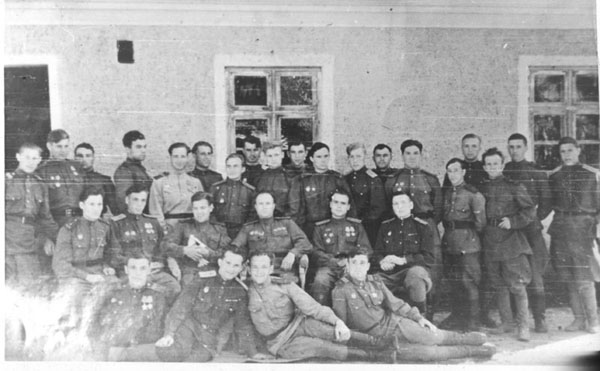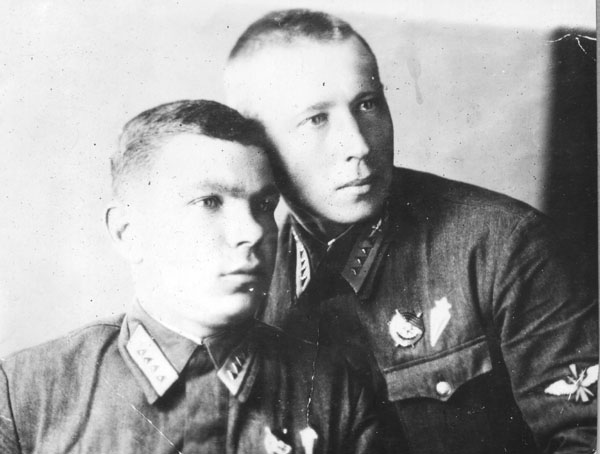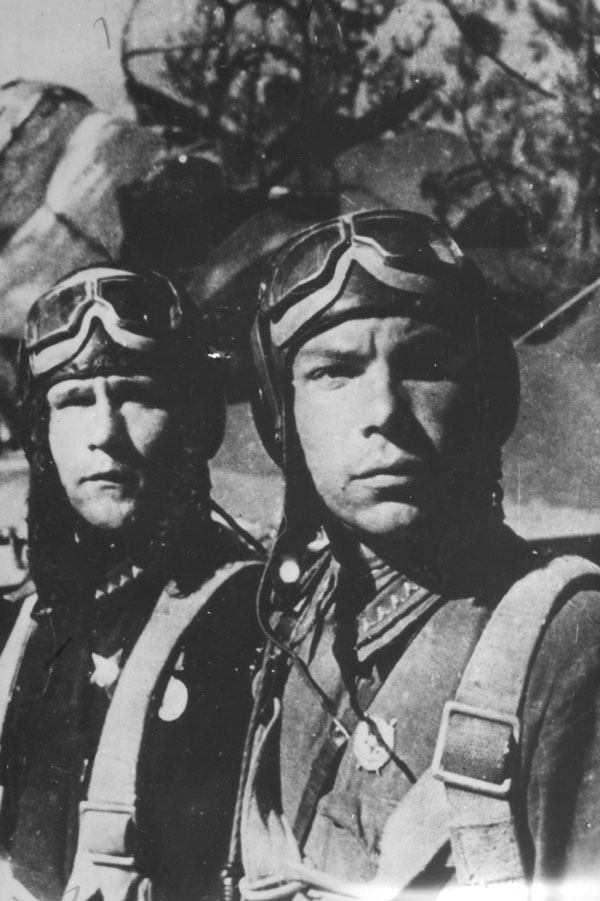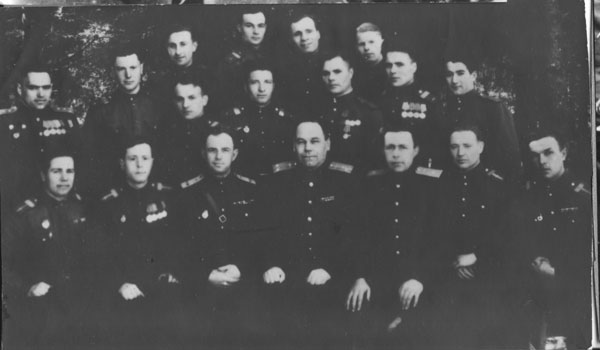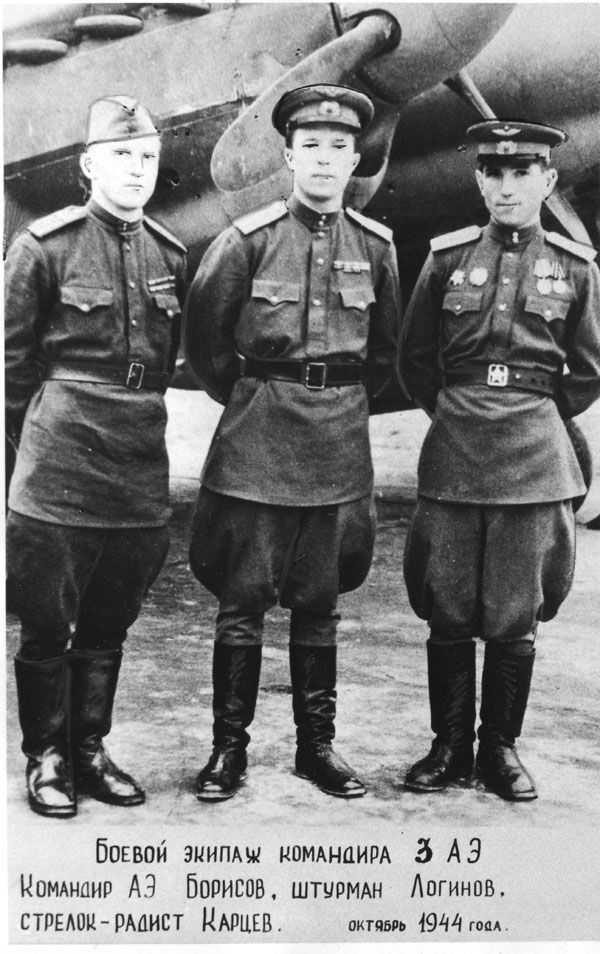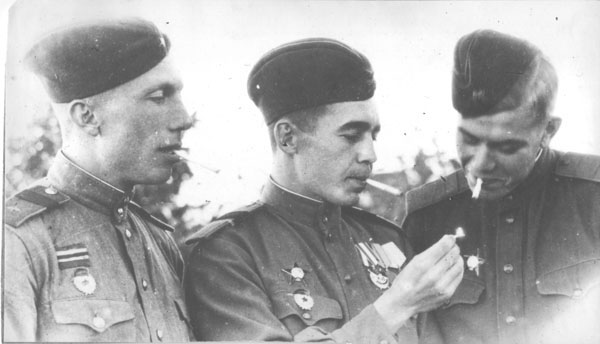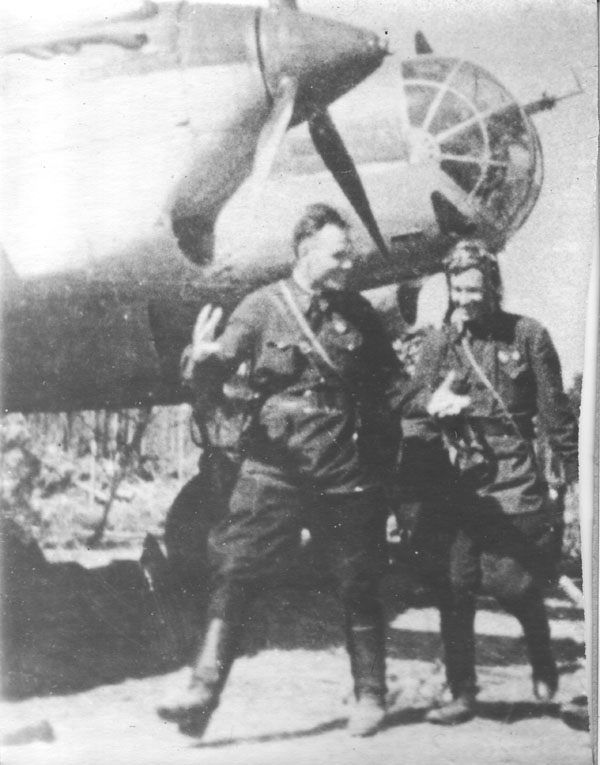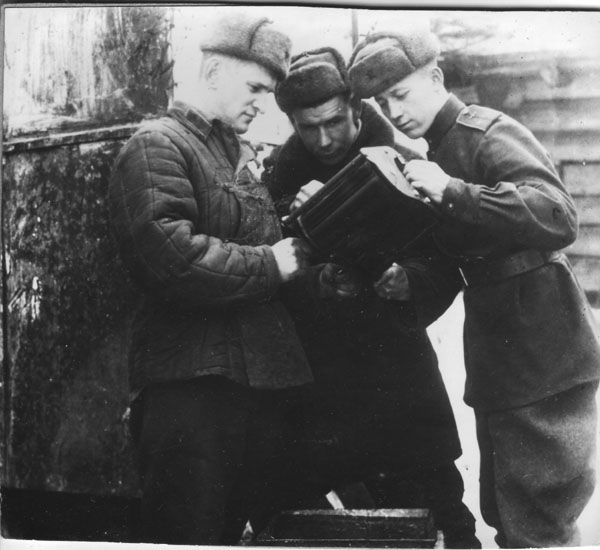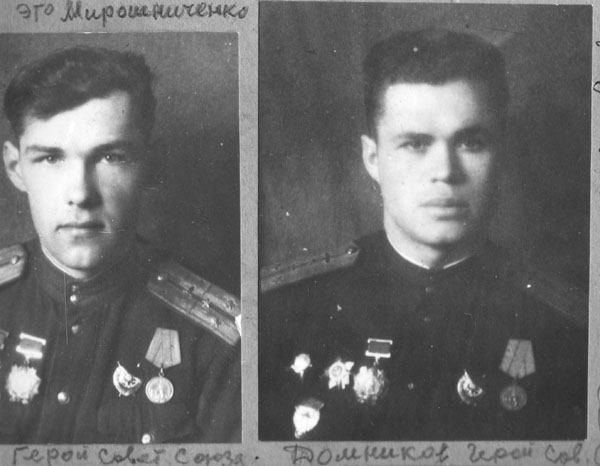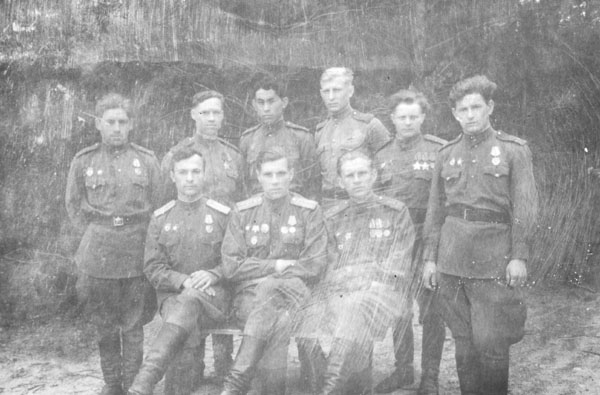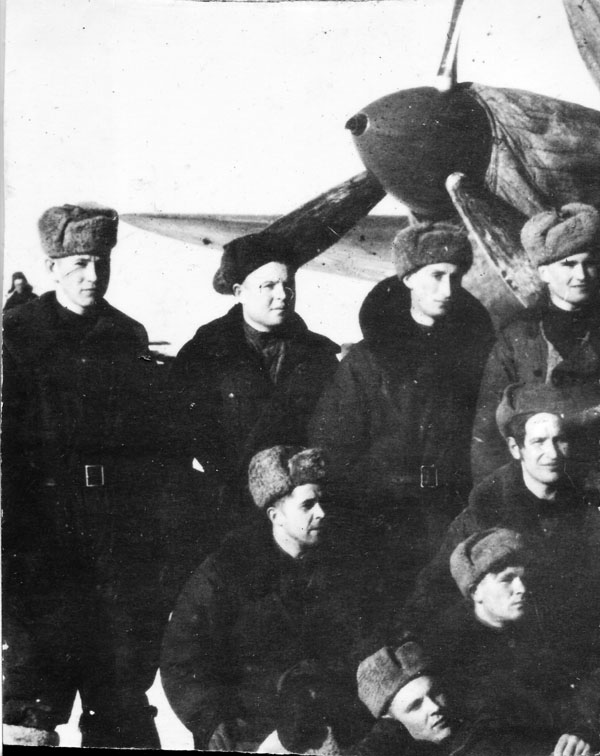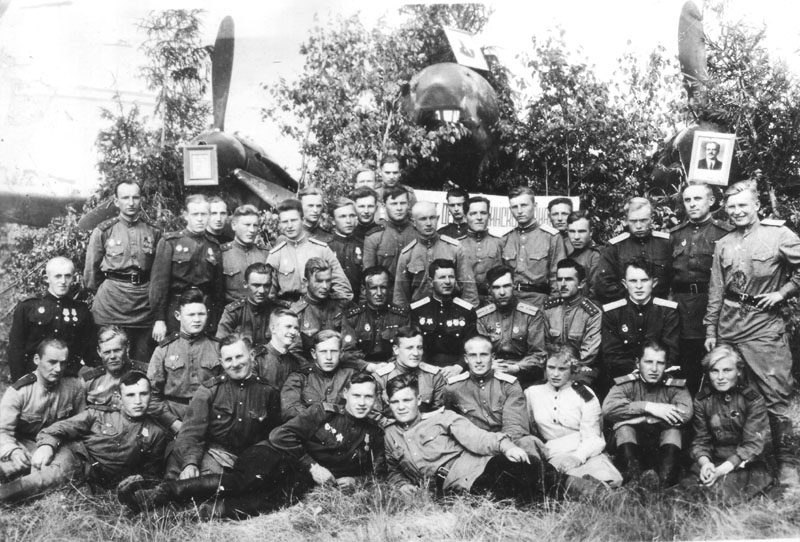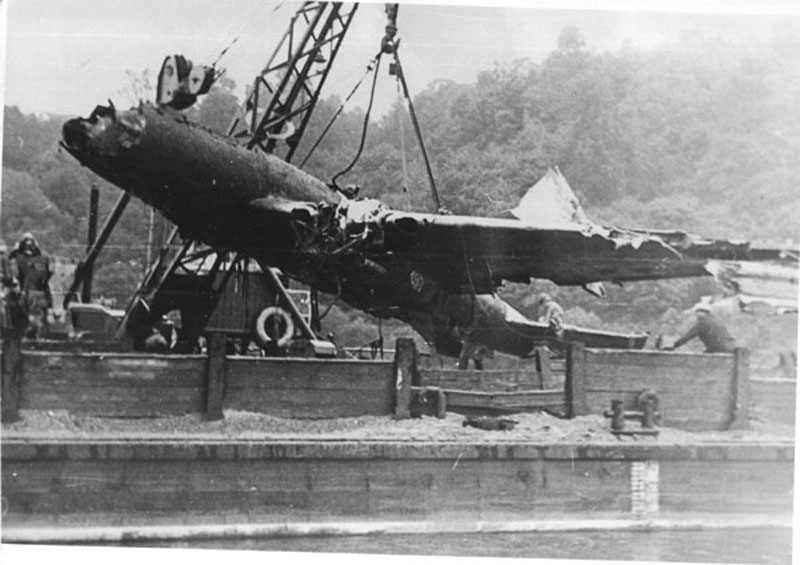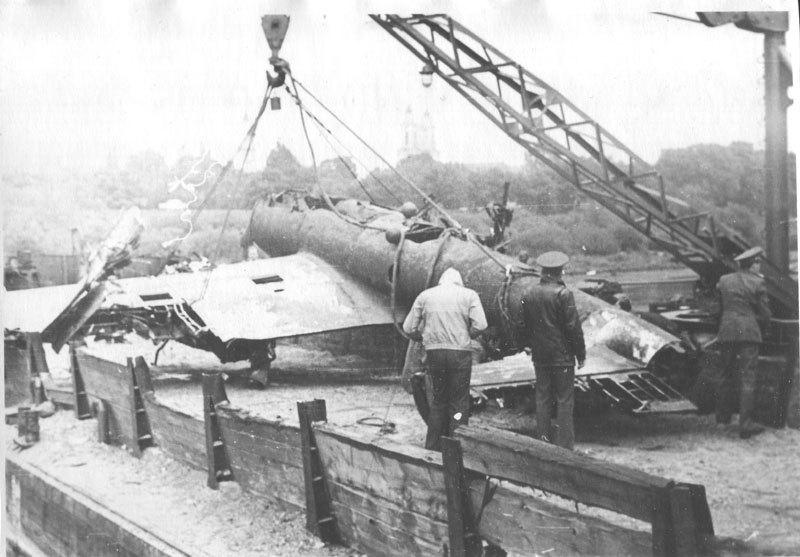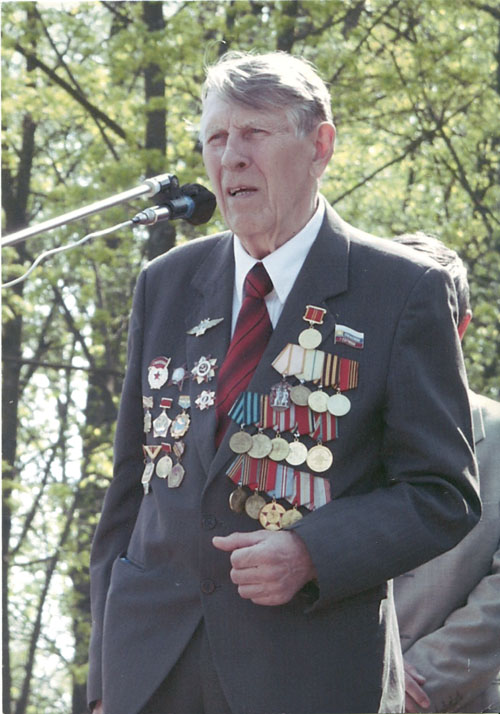
Editor: Igor Zhidov.
Translation: Oleg Korytov
Special Thanks: Svetlana Spiridonova
|
|
|
|
Interview to Vladimir Timofeevich Anisimov by Oleg Korytov and Konstantin
Chirkin.
Editor: Igor Zhidov.
Translation: Oleg Korytov
Special Thanks: Svetlana Spiridonova
I, Anisimov Vladimir Timofeevich was born on 4 August 1922, in a family
of clerks, in Moscow, in Glasov pereulok. That’s between Smolenskaya square
and Kalinin prospect. How it is called now I do not know.
My father became an orphan at the age of 9 month. There was a cholera epidemic
in Volga area at the time. Disease had engulfed a small village Pichkassy of
Spasskii uezd Kazanskaya gubernia. Neighbors, ordinary peasants, who lived through
this outbreak gave shelter to little Timofey. His new parents raised him, provided
with an ability to study. Father did not know that he was adopted for a long
time. Same as I did not know that my grandparents were not biological ones. Mom
told me this story only when I was about to go to the Army.
Dad was a gifted boy, he graduated from City high school, received a diploma
of math teacher, and this had paved his future life. 18 years old boy became
a teacher at Kazan orphanage. As he told, this work was very interesting. Then
he was transferred to Rukavishenskii orphanage in Moscow. There he had to deal
with homeless orphans, which were of almost his age.
When First World War began, he voluntarily went to the army. By 1916 there
was a severe shortage of officers, and he was sent to the Praporschik School.
He graduated just when February revolution took place.
At the revolution time there were a lot of different parties. Dad decided to
join Bolsheviks. He did not become a party member, he was just a «sympathizer».
Soviet State had a need for officers, so he became a chief of a unit for special
purpose in Moscow, but soon left this post. There was a need to build an education
system to teach people, so he was summoned to become a head of education department
for Khamovnicheskii district of Moscow. He worked there for several years. In
1923 dad was sent to the Volokolamsk, where he worked as a chief of regional
education department. After that he worked for three years as a Union official.
Later he was called to Moscow and appointed to work in a State Bank system. There
he worked until 1960.
Before war for some time we lived in Kiev, where dad worked as a deputy chief
of regional State Bank office. In Kiev I graduated from 10-grade school No 40,
which was located at Shevchenko Boulevard.
— What was your attitude towards Finnish campaign? We talked to many veterans, and their answers left strange feeling that it was not a war against Finns, but some kind of continuing war against “white” — “white Finns”.
Main attitude was: if we fight, they are our enemies. But there were some other opinions. Not for me, though. I even went to the voenkomat with my friend to go to the war voluntarily. We were not old enough, and, of course, we were not enlisted: «Wait for your turn». So I was only a witness of the history then.
— How did you become an aviator?
I was a Komsomol member, I was called to the regional committee of Komsomol
and told:
— Comrade Anisimov, you know how complicated international political
situation is? It is very tense, Nazi Germany, aggressive imperialistic intentions
of the Western countries…
And so on.
It is common to say nowadays that we knew nothing. But back in 1940 we knew
our enemies well...
I was directed to the local drafting board. There I was suggested to apply for
a place in military flight school. I replied that I wanted to be directed to
the tank forces. Just a few days before I watched a movie “Tractor drivers”.
So I decided to become an armored forces officer. But voenkom said very strictly:
— You are a Komsomol member! You should be disciplined!
So I replied:
— Fine! Yes!
Right after graduating from school in august 1940 I was sent to Kharkov, to the
aviation school of navigators/bombardiers.
Just before that an order was issued by Narkom of defense Timoshenko, which stated,
that all graduates of aviation schools, independently of specialty to serve for
four years…
— Famous order: living in barracks, graduates to become sergeants instead of lieutenants…
There were a lot of such things… As we used to say: "like cutting balls with a sickle"… We were disappointed, but there was nothing we could do. Then war broke out.
— We were told by veterans that only those with best education were directed to the navigators department…
It was a bit different for me: I was sent to navigator’s school straight away.
— We heard from HSU Yevdokimov, that they laughed at pilots: «Who is a pilot? It’s a taxi driver who brings navigator to his working place»…
Yes, we had similar jokes. We also used to tell them: «You are with “black bones”, but we are with “blue blood”»...
— How many men were excluded by mandatory commission?
Medical and mandatory commissions were both in the school. And after both there
were excluded people. But there was a commission at Voenkomat, and absolutely
unfit were excluded there.
We were very worried. Everybody wanted to become a pilot, and it would be unpleasant
to go home with “empty hands”. I was also worried, so that even my
heart was racing. Doctor examined me:
— Why is your hart beat rate so high?
I said:
— I must be worrying.
He laughed at me and allowed me to pass…
In august 1940 we were enlisted into the school, but we were given vacation
until December 1. We spent it at home, said our goodbyes to relatives and went
back to Kharkov. There we found that one man from our group was missing. Three
men were drafted from Vologodskaya Oblast, but only two returned. An enquiry
was made, and it was found out that while he was in Moscow, he was caught for
swearing in public. For that he was sentenced for a year in prison. He was released
only in July 1941, after that war started. His crime must have been forgiven,
but he was not allowed to apply for a place in the school. He served in the sentinel
squad...
Right after we were accepted we were sent to flight-training department. I opened
one box, and noticed a man’s dick drawn on the box’s cover from the
inside… It was well painted, colored, with all accessories needed. And
there was a sign:
«Withdrawn from active service for four years»…
We laughed at this joke, but if we only knew that it was a prophecy for us…
We were given high boots, soldier’s overcoat and a hat. We were very proud
of our symbols with “wings”…
There was a lot of drill practice. Discipline was highly demanded.
— Do you believe that these drills were needed?
I believe yes. It made us more responsible… And we felt it our selves.
But no one liked it, of course…
On 21 January 1941, at the day of Lenin’s death we gave our oath and
we became real military men. On this same day we received an injection in the
back against different diseases. It was very painful, and everybody was sick
for a couple of days.
At about that same time we were introduced to new method of feeding: one day
a week was announced as «dry» — everything had to be prepared
from concentrated food. In the morning – unsweetened tea, buckwheat porridge
from concentrate, piece of dry bread. For dinner – a soup made of concentrates,
and concentrated food for supper. I have to say that there was not enough food
for us, we always wanted more, so we had to go to the “Voentorg - soldiers
shop”.
— How much did you earn as a cadet?
Can’t remember precisely, 8 rubles 50 kopecks, or something like that.
At the soldiers shop we used to buy sausages and pastry… We received cigarettes
for free, on the other hand. Can’t remember the brand though. During the
war we received tobacco or makhorka. I remember that we received a pack of tobacco
with an inscription: «Death to German occupants». It was a large
pack — we were quite inspired by its size. So we went to the toilet
to smoke. First to smoke inhaled, but couldn’t exhale. He became pale and
fell to the floor. We started CPR and barely saved him… It was such a strong
tobacco!
“Young soldiers’ course” went along training in flight training
department where we studied aerial gunnery, navigation, bomb aiming, photoreconnaissance
and other military sciences.
— Was your training sufficient?
Hard to say, was it sufficient or not. There was a special program developed for our school…
— When examining wartime documents a common problem is found: navigators get lost, bomb undefined targets, groups break apart. Regiment navigators don’t know their responsibilities. What’s the problem? Was it in primary training or a war time problem?
I believe that it was a combination of problems of primary training and deficiencies of our equipment. Not only we didn’t have radars then, but we didn’t know about radio semi compasses then. We were trained to use Morse code. But at the front navigators were very experienced, and they were constantly trained by Guards Major Trunovskii. In the flight school there was a case when instructor flew around Kharkov in a TB-3, until he understood where he actually was.
— What kind of airplanes you studied in the school…
We began with R-5 and R-Z, which from navigators’ point of view were
identical. Pilot sat at the front, cadet – behind him. There was no intercom
on these planes, just a tube for speaking.
Then we flew a bit in R-10 — that’s a monoplane built in Kharkov,
somewhat resembling a Su-2… Closing canopy. We used to respect it…
I even flew a training mission in TB-3 with a group of cadets for navigation
and radio communication.
There must have been deficiencies of training. But we had good instructors, who
knew how to teach. I still remember Senior Lieutenant Mogutov, who taught us
navigation. Senior Lieutenant Primak, who was a teacher in tactics class. He
was a very interesting man. He used to give us situational tasks with Ukrainian
accent:
— So you are flying a combat mission, when you notice four Germans
appear, and all of them are crooks from a long road…
His lessons were very interesting…
Mogutov explained what a detailed and general orientation is.
— You go to the city park, and look out for a girl. This is a general
orientation. Then you suddenly notice a couple of girls. You start examining
them with more precision. That’s detailed orientation...
— How did you find out about war?
It was a nice June morning. There was no alarm sounded. It was announced at
12 o’clock by radio.
Not too far away, maybe 5 kilometers there was Kharkov tractor plant. It was
bombed just a few days later. We hid in the corn field nearby.
— You personally saw those raids?
Yes. Those were not mass raids, rather small groups, not more then a squadron.
Germans didn’t raid our school, so we kept flying. We made our first parachute
practice jumps then.
— When did you start flying?
When we gave an oath. First flight was for introduction only, in the end of
January. R-5 had open cockpit with only a windscreen... That’s why we were
issued a fur mask, in order not to be frostbitten.
When we took off, I became scared. I never flew before! Even though I was fastened
by seat belts, I kept thinking: «He will roll over right now, so I will
fall out». For about ten minutes I didn’t actually see anything,
being busy with scaring my self. Then I got used to flying…
I was notified of our route before we took off, and I had a map with me. Pilot
told me:
— We are flying over Izum now, there is a station… Here is Staroverovka.
Now we are going to make a turn. Did you understand?
I replied:
— Yes, highest trees are in Staroverovka…
So we made our first flight by a triangle route.
I can’t say that we flew often. Once a week, maybe. Those were single plane
flights.
— How many flying hours you accumulated before war?
Each flight lasted 30 minutes on average. We flew bombing practice with concrete
bombs, radio communication practice in a TB-3… No less then 20-25 hours.
I remember how Vasilii Stalin came to our school. He used to be a Senior Lieutenant
Inspector then. It was just before 1 May 1941. We were cleaning territory
for festivities when school chief of staff Colonel Lyshenko appeared. He walked
nearby and obviously waited for something… Somebody sent a rumor out that
Stalin’s son was to come.
He came in an I-16 fighter. Got out of the plane, sat on the cockpit border and
lighted a cigarette. I thought: «Smoking near a plane is disobeying discipline.
How can it be? We are trained to avoid it, while pilots seem not to care about
it at all…».
Chief of staff went to the airplane and said:
— Who allowed you to smoke at the plane?
He replied with absolute disrespect:
— Comrade Colonel, where is a chief of school?
Chief of staff understood that this was the man he was waiting for:
— Chief of school is waiting for you!
So they went to the stab to Colonel Belokon…
In June, right after war begun I was appointed as a company commander. My ancestor
Apalkov disappeared… So I was in this position at a rank of Junior Sergeant
until graduation. Cadets Company was 25 men, all navigators in the future…
Evacuation was unexpected. In August 1941 we were announced:
— Get ready for evacuation to Siberia.
Everybody, whose footwear was worn out were issued new boots.
Evacuation was arranged in organized manner. By company’s. Each one was
issued a backpack with a “dry ration”: several cans of concentrated
milk, bread, butter, sausages, and then we were ferried to railway station where
we loaded on a train. There we were told that we will be moving to Krasnoyarsk…
— Did you pass airplanes to combat units or took them with you?
Can’t say, but all instructors were traveling with us. We traveled for a short time, five days may be. Train went pretty fast, through Northern route: through Vologda, Perm, Sverdlovsk, Omsk… We finally arrived to our new location place, 5 kilometers off Krasnoyarsk. Across Yenisey River there were some industrial plants. We started our living at new location with sauna, and then we were shown our barracks, where new beds were waiting for us to come…
— Did you feel some kind of disappointment that our country was not ready for war?
We were not disappointed that we were not going to take part in the war. And we were somewhat not ready for our army retreat. We were very absolutely angry and disappointed with this fact. So we wanted to get to the front as soon as possible to change situation in our favor – we truly believed that we would deliver final blow to the enemy…
— What was your attitude then to the Party and to the Government?
We were young and believed that Party and Government would do all they could so that we would live better. We were patriots.
— And nowadays?
A bit different... There were different people in the government. But generally I still respect it…
— When instructor pilots with combat experience first appeared?
At first we had none. Several such pilots appeared in 1943, but not in our flight
— Did you keep flying once a week? Wasn’t there fuel shortage?
Maybe we flew a bit less. But not due to fuel shortage…
— Were there problems with orientation? Terrain there was very similar in different places due to the forests?
Not only forests. But no, cadets did not loose orientation, maybe because routes were the same all the times.
— How many flying hours you accumulated during studying at the school?
I believe that over one hundred hours.
— In your opinion, was it enough?
No. And first of all we needed more practice in bomb aiming. We flew only obsolete planes: R-5, R-Z, and SB. And a few flights in DB-3f. There was no new equipment.
— Which plane you liked the most?
SB. It had a large nose, where you could move freely, with a great view... DB-3 was a heavier plane and much more cramped.
— In DB-3 there was a possibility for navigator to use double control installed in his cockpit to relieve a pilot or take his place. In a Pe-2 he had to take pilots seat in order to get access to flight controls.
Yes. And there were several such cases in our regiment. For me, the more you know and can do the better. Who knows what can happen in the air?
— Could you fly an airplane?
Po-2 only. But we were not trained to fly it at school.
— When did you graduate from flight school?
In October 1943 we were graduated as Junior Lieutenants. I was sent to Reserve air regiment, which was based in Kazan. Forgot its number now. 3rd ZAP, I believe. I got there quite fast.
— What did you do there?
Officially we formed up our crews. We were sent to the front as crews. For
example, pilot - Rodin, Navigator — Pavel Gorynin…
Training was poor. To be honest, we did nothing in the ZAP, but played cards…
I still couldn’t understand why we were there until January.
— You were picked by “merchants” or sent to some regiment?
We were given an order. Our group of 8 or 9 men was sent to Cherepovets. Our
travel was accompanied by different adventures… When we reached Kanash
I missed my train. Boys asked me to go to the station canteen after the food,
so I did. But while I was standing in a queue, train had left the station.
I ran to the station military chief. There was a Starshina sitting with a moustache,
50 years old, maybe. I told him that I missed my train, that I had only financial
documents with me, because all the rest of the documents are in our chief of
the group disposal. So I asked for help.
— You know, son, go to the third floor of the railway station, stay
there, and don’t show up, or you will be sent to the penal battalion for
deserting. There will be a train tomorrow morning.
He spoke openly, so I followed his advice… But luckily, extra train was
sent in the evening, so I boarded it. I made it to Moscow, where I met others,
and then we went to Cherepovets, from which we were directed to Leningrad.
— Did you travel by "the Road of Life", or new railway?
By new one. We were on the road for a night, in the morning we arrived to Finlandskii railway station.
— Weren’t you fired at when you travelled?
No. It was on 26 or 27 January. At this time a salute for relieve of blockade
was fired…
We arrived, and went to Dvortsovaya square, to the Stab of 13th Air Army. Reported
about our arrival. Old Major began sorting us out. Pilot Nikolay Novikov was
sent to 58th regiment, while I and two other navigators were sent to 34th Guards,
to Kolokoltsev…
We received our new documents and returned to Finlandskii railway station, where
we boarded a regional commuter train…
Our new regiment was stationed at Uglovo, not far from Vsevolozsk. We went straight
to the stab. There we were sent to our squadrons. I was appointed to Major Ivan
Sirenko, who later became HSU.
— You were sent to Guards regiment. When you personally received a Guards title?
Not straight away, you had to fly for that. I accomplished 10 missions before I received a title.
— Do you remember your crew commander name?
It was Konstantin Tyurayev crew, and I flew two first missions straight after arrival, but as a gunner.
— What was the logic in sending trained navigator to the air as a gunner?
A situation then was in lack of gunners. Some were killed, wounded or sick.
Missions were to bomb Siverskaya and Vyritsa in the southern part of Gatchinskii
rayon. So we were told:
— What for they sent us navigators? We are in need of gunners…
— Was it your free will to fly as gunners?
Free will by order, since there was a need. We, of course, were disappointed.
But on the other hand we were already fighting a war…
Weather was very bad. Clouds at 700-600 meters… Squadron commander, Major
Sirenko briefed us:
— Well, eagles-hawks, we received an urgent mission. Germans
believe that we will not be flying if there is no weather. We will catch them
off guard.
So we caught them on the Vyritsa-Syverskaya road…
A few days later I was assigned to Dmitrii Kulikov’s crew, which was sent
to Kazan after new planes. Four crews were sent there with mechanics.
Navigator Alexandr Fadeev perished as a gunner.
— Which kind of weapon you had when you flew as a gunner?
I had a ShKAS in the side position and UB in the ventral firing position. As a navigator I had an UB in dorsal turret.
— We met several descriptions when gunners shot off tail fins while firing at the enemy fighters. Could it have really happen?
There were no such cases in our regiment. But it could have happened in a heat of the moment.
— Where did you receive training in aerial gunnery?
We shot at the towed cones with ShKAS in the flying school. It was rapid firing
machine gun – if you pressed the trigger a bit, whole belt would be emptied.
And it had great dispersion.
I saw UB for the first time when I already was in the regiment. At our free days
we were gathered by chief of aerial gunnery service and squadron weapons technician
Kubrak, who trained us in weapons disassembly-assembly and aiming. They were
very serious about these drills, while we tried to avoid them by all means possible…
?????????????? ????? ?? ????…
— Did you start flying missions after ferrying airplane from the plant?
It was taken away from me. Four times I ferried planes. Several days I spent
in the regiment and then I went back to the plant. Finally in May we began flying
combat missions, but we received old airplane. We both were young and inexperienced Junior
Lieutenants — pilot and navigator…
Airplanes were issued to the crews by squadron commander or deputy regiment commander.
It might be was even done by regiment commander, can’t be sure.
— I heard two opinions about Kolokoltsev. On one hand — excellent pilot. Navigators liked him for flying abilities… On the other hand he didn’t fly too much.
I knew Kolokoltsev well. We, naturally, were not friends during war time, as
he was a regiment commander then at a rank of Lieutenant Colonel, while I was
ordinary navigator. I maybe spoke with him 3 times then… We became friends
after the war. He became a chief of our division veterans’ council, while
I was his secretary. I have a lot of his letters in my archive. I was invited
for his 70th anniversary, and I was at his funeral. He was a great pilot, took
part in Khalkhin-Gol campaign. He was highly educated man. He appeared to be
a strict man he always looked frowningly at people… People were afraid
of him. Yes, he caused fear…
He flew well and a lot for his position. On 26 July, when I was shot down, he
personally led whole regiment. Two regiments flew then, 58th and 34th, 54 airplanes
in all...
— We were often told that regiment commanders flew rarely, not to speak about political officers.
Regiment commander could fly combat mission only by direct order or permission
from Division commander. I also believe that political officers did not fly missions.
Our political officer at one time was Major Ivan Sirenko, but he flew. He was
shot down in January 1944 over Chudskoye Lake. By pure luck he stayed alive.
Gunner dragged him to our side on the parachute because he was severely wounded.
Then he had a break in flying activity. He returned into the air, was awarded
by HSU title. Guards Major Perlik succeeded squadron commander post after him.
Major Burashnikov was also a political officer. He perished in an airplane crash
on landing and was buried in our presence at Mezhno village cemetery near Siverskaya.
He was a pilot and political deputy of Kolokoltsev. (Major Burashnikov and Captain
Moshkov were killed in air crash at Siverskaya airbase on 14.02.1944 due to sudden
change of weather.)
— A lot of veterans have poor opinion about political officers…
I can explain, why. First of all, those political officers who did not fly
themselves were not respected at all by pilots. Pilots tend to have indulgent,
a little bit scornful attitude towards those who can’t fly.
Secondly, example. We stood in a row with flight navigator Nikolay Savin. He
was prone to superstition, one of which was that he attached his awards from
inside of his soldiers’ blouse. If a regiment banner was brought out to
the runway, he used to swear:
— Crap, they brought it out again. We are going to loose somebody
again.
— How this episode can be attached to political officers?
They did not know our work from inside. Political officers spoke a lot, moralized
– as if they knew the situation… And we had to patiently listen to
all this…
Apart from political officers we had party organizer and komsomol organizer.
If there was one party representative, it could be tolerable, but three were
too much. Attitude towards komsomol organizer was absolutely disrespectful. He
was thought of as paperboy.
— Was there a need in them?
Maybe not. Their educational functions could be passed to commanders.
On the other hand they kept us informed about general situation in the world
and at the front…
— But still, from the height of your age: were they really needed?
I’d specify, at which year. In the beginning of the war they were really needed and played significant role. By the end of war, when everything was already clear, their role diminished.
— In your opinion: who was responsible for the situation in the regiment?
Regiment commander. He was a harsh man, damn serious. When he looked not only private, but even squadron commander felt shivers down his spine. Ordinary pilots respected and feared him.
— Were there cases of nervous breakdowns in the regiment?
Can’t recall any.
— After political officers we usually discuss special department...
I had to meet them, since I was in captivity.
On 26 July 1944 we bombed railway station Tapa in Estonia. All 54 planes bombed
well. Bombs were released by leader. On our way back we flew in a large triangle.
Our flight was the outermost. Our group was intercepted by Focke-Wulfs.
When our airplane caught fire, pilot abandoned it and bailed out without us.
Got frightened and left us behind, while I still fired at the enemy. I saw four
streams of tracers flying towards me, and fire d in return.
Gunner in our crew was Yevgenii Nesterov - rookie. Just a few days before he
graduated from gunner school with a rank of Junior Lieutenant and was appointed
to our squadron as chief of radio communications service. It was his first combat
mission. He must have died in the air. I shouted him to bail out, but haven't
heard his response. I met pilot in captivity, but gunner is still listed as missing
in action…
I saw two other airplanes from our flight burning… All three bombers from
our flight were shot down.
I thought: «how will I get out? If I will pull the ring, parachute will
catch something…» Then some force dragged me out of the plane, and
I hang under parachute cupola…
Altitude was at around 4 000 meters. Below me there was some railway station,
so I thought: «What should I do not to land there? Germans should be there».Luckily
I have landed 400 meters away from the station. I dropped parachute and ran to
the nearby forest. I ran, ran through dense forest, and then stopped to catch
my breath. I listened very carefully, but no one was chasing me…
At the fourth day I made it to some folwark. The owners were scared, because
I was looking like a bum, covered in dirt… They gave me a bottle of milk,
a piece of bread and some butter. For a long time I went through Estonian territory,
avoiding inhabited areas, to be sure not to meet German troops. Without food
or water. There was no possibility to drink water from marshes, and I stumbled
across rivers way too rarely. On eleventh day I was shot at the legs when I tried
to cross the front line. I fell…
In German hospital I was bandaged, and for two days they drove me across Estonia,
including station Tapa, that we bombed. They wanted to establish who shot us
down, AAA or fighters, as if they tried to confirm a claim. I complicated things
even more, because I told them that we were hit by AAA first, and then fighters
finished us off…
After all this I was sent to the concentration camp near Riga, where there were
a lot of wounded pilots… Germans interrogated me several times. It seemed
that they knew a lot about me somehow…
— Were there traitors among POWs?
There were no such men among us. Twice we were visited by ROA members, who
suggested joining them… But no one agreed. Their methods of persuasion
were quite strange, they asked us without any enthusiasm, and our refusal didn’t
bother them at all.
There was one interesting case. Two beds away from me there was a pilot-Major
lying without any movement. But as we understood later he simulated. He pretended
to have severe trauma after being shot down. German doctor examined him and agreed…
At daytime this Major lay as if he was unconscious, but at night he whispered
something to my neighbor. And once this Major disappeared. Where did he go? I
believe, that it was a result of ROA members visit just one day before, they
must have helped him to run away. Germans came in pretty soon with dogs; they
started the chase and interrogations…
— Do you remember anyone who was in the same camp as you were?
I remember well:
Vladimir Dorofeev, who flew La-5. (Jr. Lieutenant Vladimir Dorofeev from 63rd
GvIAP was captured on 05.04.44. After filtration returned to his unit on 03.03.1945.)
Petr Ionov, who was also a fighter pilot and flew Yaks. His portrait I saw in
“Stalinskii Sokol” newspaper in 1947 or 1948. (Two versions: Sr.
Lieutenant Petr Ionov from 296 IAP. Did not return from combat mission on 17.02.1942.
Jr. Lieutenant Petr Ionov from 927 IAP who did not return from combat mission
on 5.9.1944)
They both had burnt faces. I underwent filtration with them in Podolsk. Petr
was born in Moscow, he used to live near Novodevichii Monastery…
I can’t describe these several months in captivity in a few words. But
your question was about special department…
When our forces were near Riga, Germans left us behind. By this time I was already
walking with a stick, so I went towards frontline.
When we made it to our troops I was sent to the 101st Surgical Field Hospital.
There I was examined and bandaged… There I met special department officer
for the first time. He questioned me very carefully: how, where and when. I told
him everything once, twice, three times... He questioned me four times in all.
Then he ordered to infantry Junior Lieutenant:
— Take Junior Lieutenant Anisimov with you, so that he will repair
a road with you.
So I went with them. They had to make a wooden road through a marshland. I was
there for several days, but didn’t actually work – I couldn’t
walk well yet, so I was their chef.
Then I was sent to assembly point for former POWs. A large group was gathered,
we were taken to railway station and sent to Podolskii filtration camp near Moscow.
It was in October 1944.
— How long did filtration take?
Over one month.
The attitude there was very simple, even though there were sentries, barbed wire
and so on…
— Were there cases of tortures or anything like that?
Tortures?… That’s all lies… Usual barracks.
There were self made concerts. There I heard some famous songs. One boy, Valentin,
was a very good singer…
But there we were dressed not in uniform, but in all kinds of clothes. I was
dressed in flight suit and warm overcoat, which technician gave to me before
we took off:
— You will freeze in just a light flight suite at high altitude. Here,
take my coat.
So I spent my concentration and filtration camp time in his coat.
There were not only men in filtration camp, but women also. I became friend with
one of them. When I caught cold, she found “Codeine” pills somewhere
and treated me.
Several times I was invited for questioning. Elderly Major asked me about people
whom I met in the captivity. Which doctor operated on me? Were there traitors?
I told him all I knew. Right after New Year he summoned me and said:
— Comrade Anisimov…
All this time he addressed to me as “Comrade” or “Junior Lieutenant”.
— …You have passed filtration and are directed to the active
army. But first you will have to go to Lyubertsy, to the gathering point,
where you will be issued new documents and equipment, for now you will have this
paper which you will present there.
He shook my hand and wished me luck. First thing at Lyubertsy we were sent to
the sauna, and then we were issued new uniform made of British cloth.
On the next day I went to the VVS of Moscow military district stab. There I was
met by a female Major of about 40 years old. I reported:
— Guards Junior Lieutenant Anisimov had arrived.
She looked through my documents:
— I send you to the reconnaissance regiment, stationed here, in Moscow
district.
I said:
— Comrade Major, since such a story happened to me, I have to rehabilitate
myself in front of my friends. Could you please send me to the Leningrad district?
— But your division should be somewhere in Baltic by now. Oh, well…
So she sent me to Leningrad. There I went to that same Major who sent me to the
regiment a year ago. He told me:
— My dear friend, your Kolokoltsev is in Kaunas now. Maybe I can find
a place for you here?
So I had to beg again…
He looked at me, at my documents, and called his adjutant:
— Issue transit documents for him, so that he can go there through
Moscow.
I came to my unit on 21 January 1945. It was a Lenin’s memory day. There
was a meeting arranged to honor him. I looked through the door, and saw that
political officer was making a speech. When he finished, I entered the room.
I wrote to my friends where I was and what was going on. They shouted:
— Vladimir! Hurray!
Who cared about Lenin… They dragged me to the table… Gave me a mug
of spirit — that I still remember, but how I drank it and went to
sleep – I can’t recall.
On the next day I was invited by regiments’ special department officer
– Senior Lieutenant Sinelshikov. The room was darkened, lamp was pointed
at me, so that I couldn’t see anything. He began interrogating me with
passion. It seemed that I was guilty in surviving… I told him everything,
but felt his mistrust. That I was wounded when I turned around. Doctor was summoned
to look at my wounds. Doctor asked me to lower my pants:
— Entrance in the back, exit wounds in front. It’s all right,
he was shot from behind…
I asked:
— What do you mean “all right”?
I really didn’t know what he meant by “all right”…
Special department officer must have made enquiries about me. At this time I
got very sick. Doctors believed that I had typhus, and sent me to the special
hospital. But it was severe flu topped off with nervous breakdown. For 1,5 weeks
I lay in this hospital. Returned to the regiment, where I finally was appointed
to the crew of Vasilii Zenkin. We began flying together.
— Was there a real need for special department officers in the regiment? I believe that you were checked in the filtration camp much better then he could?
There was no need for them in the regiments. We all had passed mandatory commission,
graduated from the flight school. They might be were needed higher to fight against
spies. But what kind of information could a spy get in the regiment?
There was one case when self-wound was inflicted. Pure accident – one mechanic
shot at his leg while cleaning his pistol. So he was questioned several times…
So many young healthy men did nothing throughout the war…
— Who performed airfield guarding? Special department?
We did, our girls guarded us, they put overcoat, took rifle in their hands and…
— What was your attitude towards girls who served in the regiment?
Brotherly.
— When you flew your first mission after captivity?
First one we flew in March against Kongsberg fortifications. Then against Pillau…
— You were absent for almost half a year. How many new officers came into the regiment during this time?
August till January… - half a year. I wouldn’t say that a lot. At this time there were little losses. And when we fought at Karelian Isthmus we suffered little losses. In the Baltic we lost a lot of crews. Germans fought against us there. In Eastern Prussia we also had rare losses.
— They lacked AAA? How would you explain reduction in losses?
There was a lot of AAA. They defended Kongsberg extremely well.
But firstly, it was a cloudy winter with a few days fit for flying. Secondly,
Germans lacked fighters. We saw them very seldom. Losses over Pillau wee mostly
caused by AAA. By the way, Pilot Shishov was severely wounded there, so his navigator
had to take his place and bring airplane back home.
— So fighters caused more losses?
Yes, fighters. Especially at winter 1944 when we bombed airfield Tartu in Estonia. We took off without any confidence that we will return.
— Lets return to the flight when you were shot down. Did our fighters cover you then?
They did. Can’t recall who, 27th or 25th regiments, equipped with Lavochkins.
— Do you remember anything special about those German fighters?
I can’t remember details. Just that they were gray.
— How many airplanes were lost in that mission?
We lost 3, 58th regiment 6.
— Was anyone punished for heavy losses?
How could I know, if I was among those who were shot down… And then, more than half a year had passed… If you want to know more about this mission, you should read a book “Starorustsy”.
— Were there cases when fighter pilots were called in for discussions?
I believe there were such cases… But we never met fighter pilots on the ground, since we were based at different airfields. These discussions took place at high level. But there were a lot of complaints.
— Have you heard about punishment to fighter pilots for losses among escorted airplanes?
We heard. We were introduced to the orders concerning such cases. They were reduced in ranks or posts.
— What about sending to penal battalions or executions?
Never heard anything like that.
— One former fighter told us that it was easier for him to cover
female dive bomber regiment. He explained that they flew in tight formations,
bombed, turned around, leader reduced speed a bit so that group could gather
together and then went home. Male groups extended formations after bombing runs.
Leader would push throttles all the way forward, while fighters had to defend
each and every plane.
Was it really close to this?
For the first time I found out about female regiment only after the war. What I can say, it all depended on leader. There were such cases. My squadron commander sometimes could break formation and gather it later… In Major Klochko’s squadron such things never happened. It was a pilot of best quality – HSU Nikolay Antonovich Klochko.
— What were your main targets?
Quite commonly we flew against railway stations and enemy frontlines. For example, I accomplished my first combat mission in a role of navigator at Karelian Isthmus. It was two minutes of flight away from Levashovo. We bombed front line, trenches.
— You bombed from level flight or dove?
From shallow dive. It was a cloudy day, so we were limited with altitude.
— The steepest dive that Pe-2 could bomb at was 70 degrees?
Yes. But we used it only for training. In real combat we never used 70 degree dive. We dove from altitude of 3 000-3 500 meters with an angle of 20-35 degrees.
— Did you use time delay fuses?
Yes, for dive bombing a time delay for a few seconds was set in bombs.
— You dive bombed in formations or by single planes?
We usually flew in a flight formation, when used shallow dive bombing, but sometimes we did it by single planes.
— Did you use cluster munitions?
We did. Incendiary bombs, small fragmentation bombs, ant-tank PTABs.
I never flew with PTABS, but from my friends experience I can say that they were
used to “saw” suspicious area.
— How did you confirm destruction of a target?
There was an AFA-13 photo camera in each airplane, so everyone would make a photo of his run. There were no special planes for photo control.
— So you had to drop bombs, turn around and make a second run to make photos?
No, we made photos at the moment when bombs were released. Camera had a wide angle of view.
— Who and how assessed strike results?
There was a chief of aerial photo service Senior Lieutenant Sinkov, he was
promoted to Captain later. As soon as we landed, he collected photo cameras,
developed films and printed pictures. In about 30-40 minutes the results were
ready.
It was important for us to have a picture, or combat mission wouldn’t be
accounted for. If there was no result on the film, it was not a combat mission.
— Were there debriefings?
Yes, of course. We returned, landed and went either to commanding post or listenened to squadron commander right here, by the plane.
— You have very few photos of war time period. Is it because you were forbidden to make photos?
It was much simpler than that: we had no cameras. Those photographs that you see were mostly made by Alexandr Sinkov, while commanders didn’t care about it.
— I had seen a lot of strike photos, but all you can see there is usually smoke or a cloud of dust.
No, photos usually confirmed the results. If you bomb station or trenches, you will see station buildings or these same trenches. And if you hit those trenches, you will kill those who were sitting there.
— When Germans brought you to Tapa station, did you see the results of your strike?
I was satisfied with what I saw. We hit them good. A lot of station buildings
were destroyed. Railways were like corkscrew… It was obvious that station
was hit with bombs.
In Rybalko’s memos he described how much damage exactly we did there…
Even though Germans are very accurate by nature, it took them 10 days to repair
the railway.
— In your opinion, how Finnish and German air defense was organized? Your opinion about your enemies as of professionals?
I can speak scornfully about Finns. They had weak aviation, which was much worse then our. By the way, in June or beginning of July 1944 my gunner had downed a Brewster with strange paint - reddish, orange-red…
— Why do you believe that it was a Brewster?
Why? Because we knew that it was Brewster. We were told and shown their description, there was an album of silhouettes of enemy planes at our stab. It was downed here, south of Vyborg. Between Vyborg and Western part of Leningrad Oblast. Closer to the Gulf. The fight took place North-West of large lake Imala-yarvi.
— Why you decided that enemy plane was shot down?
It began smoking heavily, and plane began falling with no sign of control.
— It is strange that you describe it as orange… Couldn’t you have been mistaken about its color due to sun reflection or something like this? According to Finnish sources they had no such planes…
It was not pure orange, light orange, I’d say… Maybe pink. I saw
this color, and gunner Pavel Gryaznev saw it too. That’s how we reported.
We did not discuss why it looked orange, because there is no sense in discussing
what we saw...
— were there cases when regiment did not accomplish its mission: didn’t reach its target, or bombed wrong location? Hit our troops?
Can’t recall any such case. We never hit our target, that’s for sure. But I know that bombers from other regiment bombed our supply column on the road near Vyborg. What was done to prevent such cases? I don’t know. Most likely, the punishment was severe. We were gathered, situation was described, and we were asked to be very cautious during bombing runs.
— Please, describe how plane was prepared for mission.
Mission was announced a few hours prior to take off, but no less then one hour. It depended on the way how order was passed to regiment commander…
— The order was made by ground troop’s request?
I can’t answer correctly. I was an ordinary pilot then, so I had no idea
how all this was arranged. We found out about it later. Somewhere a troublesome
situation had risen or our advance was planned. Air army stab issued an order
to Division stab after Front commander or infantry Army commander sent a request
for air strike.
Division commander gave task to regiment commander. Several hours could pass
until regiment received an order. Sometimes an urgent request can be announced.
For example, Vasilii Nikushkin was summoned for reconnaissance mission when he
with his crew was eating at the canteen. They boarded a truck and were brought
to regiment commander, who briefed them, so they took off just one hour later.
— How detailed was the briefing? We spoke to the sturmovik pilot, who was very emotional in expressing his displeasure about given tasks: «There, in the forest, between two pine trees there is a birch. You have to destroy machine gun which is three meters away from it». Infantry men had no idea what pilot saw from an altitude of 3 000 meters at a speed of 400 km/h…
Sturmoviks flew at low altitude, so experienced pilot could find that birch.
We were given different tasks. Most commonly we flew in groups and bombed by
leader order. Solo aiming was uncommon.
Squadron commander gathered us and announced:
— Boys, we are going there, the task is to bomb such object. Samofalov’s
flight will go, I’ll clear the situation now…
Commander described a task, navigator gathered crews and told us how we are going
to fly there. Firstly we will reach this point, then this. Here we will begin
bombing run. Each navigator drew a route of mission on personal map. It is a
complete lie that only leader knew the course and target location.
— Most likely you didn’t know fighter dislocation and area of their operations. But did you try to avoid AAA by setting course away from their known location, or just flew right over them?
It all depended on how well the situation was known. Of course we set course
by safest way, and that’s why we flew with “broken” route.
Depending on intelligence data about AAA site locations and active fighter bases
commanders and navigators drew their routes by safest way.
— Did you care about German visual identification and warning posts? Or you simply did not know their location?
We did not think about them, because there was no such data given to us.
— How long you had to fly bombing run?
It all depended on distance to target, type of target, intensiveness of AAA
fire or presence of enemy fighters. About one and a half minute usually.
Maybe two, three minutes.
— What type of bombs you usually used and what was standard payload?
We carried FAB-100, FAB-50 in bomb bays, and FAB-250 or FAB-500 on external
hangers… Pe-2 could lift up to 1 000 kilograms of bombs. But we flew
old planes with maximum load of 800 kilograms.
On some planes, mostly squadron commanders and regiment commanders, there were
bulks for RSs. And on reconnaissance planes. But they were strictly forbidden
to use their ammo. Reconnaissance data had to be brought home at any cost.
— You had standard load or bombs were specially selected for each target?
For each target special selection. If it was live force we used light fragmentation bombs in cassettes. Small ones, 50 kilograms and less…
— In 1941 an order was issued, that planes should be sent out on missions with full load. Veterans told me that this order had negative effect since it reduced variability of bombs used. What is your opinion?
I haven’t heard about such order. We used bombs depending on target characteristics, when we flew against Mannerheim line we dropped FAB-500s.
— With time delayed fuses?
Of course. Depending on target and release altitude. If bombs were released from high altitude there was no need for time delay at all. The lowest altitude was 700-800 meters, in this case 30 seconds delay was used…
— Who gave an order which bombs to use?
Regiment Commander and Navigator ordered how many planes will be sent out, types and amount of bombs for each plane. Some planes could lift up to 1 200 kilograms, some couldn’t.
— Pe-2s lifted 1 200 kilograms?
Yes. But it was in overload even for new airplane… Mostly – 800 kilograms.
— Could different planes in one flight be loaded with different bombs? That is, one plane is loaded with FAB-100s, another with FAB-50s and third with PTABs?
I don’t believe that it was possible. If we bombed live force, all planes were loaded with OFABs in bomb bays and FABs on external load. But all planes had similar load…
— Did plane navigator know which bombs were hanged to the plane?
Of course. Our weapons mechanics were mostly girls, so we had to help them hang those bombs.
— If you believed that other load out would be more effective, could you propose to change it?
Ordinary crews couldn’t do it. Commanders’ order was a law for subordinates. If Decision was made, no advices, recommendations or objections were taken into consideration.
— How many missions you have flown? And how many after returning from captivity?
During war I flew 34 missions. On 26th sortie our airplane was shot down. After return from captivity I flew nine more missions. I was allowed to fly in March, but weather was poor and airfield was soaked…
— Pe-2 was designed as a fighter, but later was adjusted to bomber role. At about the same time Germans had developed Me-110. They even looked alike. Me-110 had better guns and could carry similar or larger bomb load. In your opinion, Pe-2 was effective enough?
Interesting question. I found out that Pe-2 was designed as fighter only after
the war. In 1947 our squadron was sent to movie shooting site where a film
“Stalingrad battle” was made. For three month we participated in
filming. We were landed at Gumrak airfield, German hackens and crosses were drawn
on our Peshkas. We flew pretending to be Me-110. That’s an illustration
for similar looks of these two planes.
By foreign experts’ opinions, Pe-2 was one of the best bombers of the WWII…
When our school was based in Krasnoyarsk, Pe-2s were ferried to the front. They
flew from Belyy – that’s an aviation plants airfield in Irkutsk.
There were a lot of accidents and even catastrophes with them. There were cases
when planes burned right on landing. It scared us, so we even thought how not
to be sent to Pe-2 regiments. We thought that it would be better to be sent to
DB-3f, SB or Po-2, but not to Pe-2. When I arrived to the regiment, my opinion
completely changed. Our pilots were well trained.
— How would you explain those accidents? Inappropriate crew training or bad quality of new planes?
Bad crew training, most likely. This plane was just rushed into production.
Pe-2 was efficient enough. From my point of view – it was a good plane.
— But SB was better in piloting and carried more bombs?
While Pe-2 had higher speed, was more maneuverable, it could dive…
— But you said that you didn’t dive.
We dove, but in a shallow descent. On several occasions we dove at 60 degrees.
Quite close to Gatchina crew of Major Grechishkin had committed a heroic act.
They had rammed a large caliber artillery site that shelled Leningrad. They were
hit in a steep dive – it was used for precise bombing.
Pilot and navigator became HSUs. At the Gatchina city cemetery there were two
monuments erected. Gunner managed to bail out at the last moment and survived.
He was captured, survived in POW camp, returned, and was awarded by Patriotic
War Order.
— Shouldn’t defensive armament of Pe-2 be increased?
I think yes, navigator was adequately armed, but gunner should get better weapons. ShKAS was very unpredictable gun, and it had to be moved from one side to another.
— How many rounds did you have?
A box. Can’t recall how many. It would be better if we had more, because sometimes we had to fight for a long time…
— How often did you have to fend off fighters?
Not too often. Three or four times, maybe. On 26 July we ran out of luck and were shot down...
— If you were attacked by enemy fighters, when you opened fire at him and how you established correct moment?
They always attacked us unexpectedly and always out of the sun. We had to be
very cautious. They tried to get to the rear hemisphere… We opened fire
at them by personal judgment… We begun firing when he approached us, not
in order to shoot him down, but just to break his aim and make him turn away...
They were scared too.
I never thought that now I’m firing for barrage, and now to kill. But I
looked at him through gun sight, and bullet tracers were clearly visible, so
I adjusted my aim. Enemy pilot also saw stream of tracer bullets flying at him,
and he begun to maneuver trying to avoid getting hit… He wanted to live
as much as we did…
— Who was the first to be attacked by enemy fighters: leader, or anyone who just got in the way?
Whoever got in front of them?
— Bomber formation defense was organized, or everyone was for himself?
In our regiment it was organized.
— Did you plan it on the ground?
Not before each flight… When we had free times that we could spend for
training, during periods of bad weather…
Senior navigator gathered navigators, chief of radio connection service gathered
gunners, regiment commander summoned pilots. Then they discussed and trained
different defensive settings depending on threats.
— Did you have gunnery practice?
Not in the regiment. We fired live rounds for practice only in the school, while in the regiment we had only theory.
— Have you personally seen that you hit any attacking fighters?
No, I fired at them, but didn’t shoot anyone down… Fighters weren’t
too keen on getting close to us. If attacker saw tracers flying towards him,
he immediately broke off. I can’t say that Pe-2 was such an easy target.
When a large group flew, and all gunners fired, fighters stayed far away. They
tried to surprise us, hit cripples, hit with one short burst and run away.
— Have you used AG-2 or AG-10?
Not on every airplane, and only at the last days. I personally didn’t use it, and there were no planes equipped with aviation grenades in our squadron too, but we heard about them. I know that 58th regiment used them with good effect. 58th regiment was first to use dive bombing on daily basis in our division. We bombed from shallow descent mostly.
— And how effective was this system?
It first appeared at winter 1944, when they flew against Tartu. It was used with good effect, as it fended enemy fighters from their favorite position. But once again – I can tell this from other people words only.
— Could a group of Pe-2s race away from enemy fighters at full speed?
I can’t recall such case. Fighters had greater speed then Peshkas. In theory it was possible, as Pe-2 had top speed well over 500 km\h, but different planes had different engines, and such attempt could break the formation allowing enemy to shoot us down one by one.
— Did pilots use their machine guns to fight aerial targets or strafe enemy on the ground? I believe they had two UBs or one UB and one ShKAS?
They did. Not at the fighters or bombers in the air, but ground targets. When we flew against airfields they strafed the enemy before pulling out of the dive… Just for pleasure…
— HSU Yevdokimov, who flew Bostons told that strikes against enemy airbases was pretty low, and explained it by good camouflage measures, decentralization of the planes and heavy AAA cover, not to speak of need to release bombs from high altitude. Is this a correct opinion?
I believe that it might be correct for Bostons. But on the opposite hand…
On 7 November 1941 Germans planned an air raid against Leningrad.
A Pe-2 regiment under command of Sandalov was given a task of delivering a prevemptive
strike at airfield in Siverskaya. Germans were caught by surprise and suffered
great losses. Photo control showed 40 destroyed and damaged bombers, if I’m
not mistaken. Germans were absolutely not ready.
Sandalov became an HSU and General-Major later.
Another example: 1945. Our regiment received an order — disable airfield
Noitif in Eastern Prussia by cratering its runway.
Strike was exceptionally precise. A lot of planes on the ground were damaged.
But most importantly, bombs fell straight to the canter of runway, and it was
completely inoperable for some time.
This sortie had placed a final full stop in awarding Nikolai Rolin with a title
of HSU. He flew a lot of missions, and for 150 missions flown he could be presented
with a title.
Speaking of Boston, I didn’t like it… By the way, ferrying pilots
in Krasnoyarsk wrecked them quite often too…
— When you landed on former enemy airfield, have you seen wrecked German planes? There are a lot of photos, where our pilots are pictured among wrecked of the enemy planes…
No, I haven’t seen them… Perhaps Germans took wreckage apart for scrap metal… Photos were most likely made by fighter pilots, since they were first to be based at the enemy fields. We were stationed 50-70 kilometers behind frontline.
— It is known that Germans left a lot of booby-traps behind and a lot of our troops were killed by them.
We were worn about this. Deputy regiment commander for political work talked to us about being cautious. But I haven’t seen anything like this, once again, because we landed on airfields previously occupied by our other units.
— How your airplanes were painted?
White at winter, but it was not paint, it was something that could be easily
washed away by water. At summer — green with yellowish spots. Mostly,
one color green.
At the last month of war some planes came from the factories with green-green
camouflage.
— Were there Pe-2s painted gray?
There were gray planes, just one color gray. But mostly we had green ones. Some dark green, some – light green. Very few planes had a camouflage.
— How effective was camouflage in the air?
Hard to say how effective it was… I didn’t think about it at the time… Sometimes, especially at foggy or cloudy weather we noticed that on final approach airplane would “melt” in the underlying terrain, but it was not a matter of camouflage. Single color plane was identical in this. At an altitude concealing paint did not work at all – planes were still visible.
— Were there paintings or insignias on the planes?
Yes. At the fuselages of Major Klochkos planes there was an insignia: «Leningrad». On the left side there was a picture of «Brass horseman», on the right — «Lenin on the armored car». It was painted this way because planes for this squadron were paid for by laborers of Leningrad. They came to our regiment and overpainted 9 planes that were ferried to the airbase by this time.
— Were there fast recognition elements on your planes?
Each squadron had special spinner color. At 1st — red, we in 2nd had light blue, 3rd — yellow.
— What about airplane bort number?
All white on the rudders. There were no rules of numbering planes.
— Were there problems with new planes?
You should ask a technician about it… Mostly we received good planes. But of course there were some planes with quality of assembly questions. But that can be seen even today on automobiles.
— Your attitude towards ground crew?
We were friends with them, and navigators even closer ones. Pilots tended to joke at them. Technicians were good guys, cared about us. We all were young, while they were 30-35 years old. They had worked on many different airplane types. Batalov, who had a nick-name Batya was in aviation from 1932. He was very observant, always gave good advices, or cheered us up, if needed.
— Were there cases if something happened to the planes because of technicians or weapons mechanics mishandling?
Yes. Not something important. They were punished for that.
— Were there cases when pilots would chase a mechanic with side arms?
No. But Vladimir Dorofeev who served in Vasiliy Stalins regiment told us that Stalin did. You must have heard about this, if you ask?
— No, I heard it from Sturmovik pilot, who couldn’t attack enemy because all his weapons electrical system was disconnected before mission, so he chased his weapons mechanic with a pistol quite willing to kill him.
No, we only could express our anger by words. There were cases when some instrument would fail because technician did something wrong with it, but at that same time it took them one winter night to change an engine.
— It seems that you had an “unlucky” plane. At least twice you had to return “on a prayer”. Were there discussions about it with technicians?
We informed CP about malfunction by radio, that we bombed some target behind enemy lines and have to make a forced landing. It was not regiment commander who was sorting things out, but squadron engineer Vassilii Chertopolokhov personally had to look through airplane with its technician. But what could we do about engine technicians? Well, they graduated from ShMAS with a rank of Junior Aviation Specialists and were not good at working with mechanisms.
— Were you disappointed that you were unable to reach main target?
Of course, it was a matter of honor — find target and bomb it. You had to accomplish your mission and return empty… Return home after failed mission… What others will think of you? So we bombed Finnish trenches and destroyed blindage. On the other hand it was another accomplished mission. What if I will live up to 150 missions, and will be presented for HSU title? What if...
— You came to regiment commander and reported about your return, so what happened next?
Kolokoltsev was a strickt man. At first:
— What happened?
Pilot reported that engine was heating up, so we had to fly home on one engine.
Engine was really overheated, so it was dangerous to go further. If second engine
would overheat we would have to belly land at the enemy held territory. That
was not an option. That’s why pilot chose to return. Regiment commander
listened to us and said:
— Fine. We will look to it. You are free to go.
In the other case, when we had to make forced landing after bombing Vyborg, radio
disappeared from a plane. It was very bad — it would be better if
we lost a machine gun, then radio. Kolokoltsev then not to say that yelled at
us, but asked very strictly.
— Why did you make a forced landing? There is an airfield Immalan-Yarvi
nearby. You should have landed there. Bad judgment. Go away.
— You had two cases of emergency landings one after another. And technical problems were the reason in both?
Not in the first case. A shell fragment had hit a fuel line, so we lost all
fuel. It was strange that we did not catch fire. God’s will.
Technicians looked through the plane and didn’t find serious damage: propeller
blades bent, fuselage scratched… they reported that airplane was in good
condition, disassembled it, brought it to our airfield and assembled it back.
Deputy division commander Glotov had different opinion on this case then Kolokoltsev:
— Pilot made a right decision, managed to land airplane with minimal
damage, and so on.
— Which criteria were used to write damaged plane off?
Very serious damage. Sometimes even a single shell fragment led to such damage that plane became irreparable… But it happened rarely, once or twice...
— What do you know about burring of Peregudov and Grechishkin by germans?
When I came to the regiment, I was told how they did their heroic act. When
we were stationed at Siverskaya airfield a telegram from stab came, stating that
they were awarded with HSU title posthumously. Regiment commanders were summoned
to the division stab to Gatchina, where there was some kind of celebration. When
war ended we returned to Siverskaya again.
After the war there was a rumor that somebody had seen Grechishkin in the train.
There were a lot of former POWs returning home then. So there was an opinion
that Grechishkin bailed out and was captured by Germans…
Grechishkins Deputy Sheludkov, who took over command over flight, had described
how they perished.
I did not know about their burial, but a few years ago we with division commanders’
widow were passing past the Palace.
During war she used to work in the secret department of the Division stab, she
was very beautiful. After the war she married Division commander, and died just
a year ago. So she told me that when she went to look at the monument to Pavel
I, she had noticed a grave, with an insignia «Peregudow».
What else I can say… Valerii Peregudov, a Heroes son is living in Gatchina
now, works as a teacher at school…
— Was it a common situation for Germans to bury fallen soviet pilots with all respect?
I never heard of another such case.
— What was your attitude towards Germans?
Of course it was an enemy.
— You can be afraid of your enemy, hate him or even despise him.
You know, there was a song «Holy war»:
To rotten fascists
Let's send a bullet in a forehead.
To mankind spawn
Let's hammer together a strong coffin
Everything was made by Germans them selves to ensure our hatred. There were a
lot of Ukrainians in our regiment, where they left their loved ones and relatives.
After liberation they received information that their relatives were shot, hanged,
and burnt alive… It all became widely known in the regiment.
— Well, they left an awful fame behind them here too… Here, in Gatchina, there used to be a concentration camp. But still, what was your attitude towards them? Just hated, or maybe respected your enemy?
What for we should have respected them? For shooting at us?
Of course they were just enemies and we felt no respect towards them. But I always
respected German people. I liked Heine, Goethe, admired German scientists and
their antifascists…
But when some sorry German got caught, we might even feel pity on him…
We are very sentimental nation, so we are not ready to finish off fallen enemy…
I, for example, did not allow myself to do anything like that, and most of the
men in our squadron would not allow it too.
— Didn’t you think: «When we will get to Germany, we will make them suffer the way they did to us»?
Some used to say “eye for an eye, tooth for tooth”, but mostly those who suffered the most.
— When you were stationed in the Baltic’s, what was your relationship with locals?
There was a case in Kaunas. I returned to Kaunas from Leningrad by train. It
was filled with cheerful people, and there were some girls too. One very pretty
Lithuanian girl turned her attention on me. We singed songs together, and then
I told her about my life. When we arrived to Kaunas, she suddenly said to me:
— Vladimir, don’t go out late, because there are some fascists
that shoot at soviet officers at nights.
That I remember, that happened in Lithuania, not in Estonia. Estonians didn’t
like our people at all.
On the other hand I never heard that our bases were attacked by “forest
brothers”.
— There are a lot of accusations towards Red Army that they were marauding…
What do you mean "marauding"? I brought some trophies home – deer horns and an ashtray with an insignia «Ortelsburg»
— One thing is horn; the other thing is to take a painting from a museum…
Can’t say about paintings. We were stationed several kilometers away from town Ortelsburg, which is in Poland now, and has a new name now. We went there, just to take a look. The town was simply reduced to rubble, without any population. In Eastern Prussia towns and villages were almost absolutely uninhabited. Population had left them… We walked into one house, where I noticed these horns and took them… Nikolay Rolin found some broken bicycle, repaired it and then rode it to go fishing. When weather was bad he took hand made spinning and rode to nearby lake, which was full of fish…
— What about radios or accordions?
Well, no. Gunners used to take something small, like paper knives. Pilots thought of them selves as of respectable people, who were way too serious for such staff…
— Did you use grenades for fishing?
We did not. But in other regiment they used high explosive charges. After the war, in 1946, when we were stationed in Chernyakhovsk, there was an awful case. There was a lot of fish in the canals. We were actively fishing there. Once, when we sat on the canal bank, General Shevcheko approached us. If I remember correctly he was a shturmovik Division Commander. He went a bit further along canal, lit the cord of the high explosive charge, but it exploded right in his hand, tearing his hand off. He stood there, swearing out loud. We ran to him, bandaged his wound and took him to the town by car.
— What was “spirit “chassis””?
It was a beverage made by technicians. They took an oxygen bottle with a metal tube, filled it with brake fluid, heated it and received spirit… It was a bit sweet and had a smell of rubber or something. But it could be used for drinking.
— Did you drink it?
Yes…
— What do you think about issuing 100 grams of vodka after flying day?
I didn’t care. I was not into drinking it. Besides, vodka that we got had a distinctive taste of petrol.
— 34th Guards bomber regiment must have been the most effective regiment, at least at the Leningrad Front…
21 HSU in the regiment!
— What do you know bout destruction of Tolmachevskii Bridge?
I heard three descriptions which differ in details. They are united only in naming
the star of this strike – Sergey Glinskii.
First version: It was destroyed by dive bombing.
Second version: it was a group operation, but part of the group played camouflage
role by pretending to bomb the bridge from high altitude, while Glinskii level
bombed it sneaking in at 150 meters…
Third version: He flew alone, pretending to be a Me-110 fighter, dropped bombs
and flew away, while Germans were trying to understand what had happened…
Yes. Sergey destroyed this bridge by special bombs equipped with parachute
and hooks.
Second version is closest to real life.
We spoke to him after the war, here in Siverskaya. There was a lot that he told.
He was shot down and captured too, but managed to escape from a train cart. Made
it to the partisans, actively fought with them and was later brought back by
airplane. He liked Kolokoltsev very much and respected him as an outstanding
pilot. In the end of war he was given HSU title.
I was also told about this operation by HSU Nikolay Terenkov…
— I heard that this bomb construction was suggested by some navigator, if not by Terenkov?
It was Terenkov’s idea, but bombs were produced somewhere else by Marshal Govorov’s order. The idea was later utilized throughout the air force.
— Could you say a few words about your comrades from the regiment, for example - Kovanev?
Excellent man. Firstly, great commander, leader and pilot… It was a man from capital letter. He flew a lot of missions in different types of airplanes. I can only praise him. He died just a year before 60th Victory Day anniversary in the age of 94.
— What else can you say about Terenkov?
When you go to Siverskaya, there is a ravine. When I have to go past it by
train, I recall how we wrecked a machine gun there.
We went there to check aim of a machine gun. Terenkov was a chief of the procedure.
We placed a target at the ravine side, put a machine gun on a tripod, inserted
aiming tube into the barrel. We loaded the gun, he pulled the trigger…
Machine gun was ripped to pieces, tube flew away… We forgot to pull it
out!
Luckily, no one was wounded, but we had to somehow write off this machine gun.
— What about Glinskii?
I already told about him. It was an intelligent, highly educated man. He died when he was just over 50 years old. I remember, when we buried him at the North Cemetery, his teacher came, and said a lot of worm words about him.
— I heard that Glinskii preferred level bombing, while Klochko liked dive bombing. Do you know why?
Glinskii was very brave man. Maybe he was given different tasks. Or maybe he
was sure that level bombing was better, that his navigator would be able to aim
precisely from level flight.
He succeeded regiment after Kolokoltsev.
— Do you know why Glinskii was sentenced in 1948?
I have never heard about it… We were not told, he never spoke about it…
— Was Kolokoltsev HSU himself?
No, he wasn’t.
— Did your regiment commander hold presentation lists: «No one will get it until I will»?
There was nothing like this in our, 34th regiment, but there was such problem in 58th regiment. Even Rybalko wrote in his book that there was such attitude by regiment commander. Several pilots flew over 160 missions, but he did not pass award lists for them…
— That is, even if pilot flew over 150 missions he might not have become an HSU?
Of course. In our regiment Major Perlik flew 160 missions… But there was something, somewhere… Well, he was caught on something.
— What about Markutsa? He was shot down, gathered a lot of ground troops around him, they fought actively in the German rear, effectively breaking communications and destroying German depots.
Yes. A legendary personality. But I had no chance to meet him in person.
(Sr. Lieutenant Pavel Markutsa perished in an air accident on 22.11.1941. HSU
by order of 22.07.1941).
We also had an HSU Petr Zolin, and a ral tragedy happened to him. He was sentencened
for a crime.
After the war we returned to Siverskaya. On the next day our former squadron
commander Captain Zolin arrived from Moscow. He and his navigator Nikolay Kovalev
got drunk celebrating their meeting. They went for a walk through Siverskaya
and made it to the bridge across river. Then the river was quite wide, and young
people were sailing in boat – a boy and two girls. Captain Zolin noticed
them, and shouted:
— Hey you, get over here! Boy, you get out, we are going to sail
with girls.
Boy was shocked, and tried to talk to them:
— Comrades, what are you doing!…
Zolin got his pistol out, began shooting without aiming, and killed one girl.
He was arrested on crime scene. In two or three days there was a court martial.
Whole regiment was there. He was sentenced to execution by firing squad, stripped
of all awards and HSU title and so on... But it was peace time already, and most
severe punishment then was 10 years in jail, so execution was changed for 10
years. Zolin was sent to Izhorskie Zavody construction site, worked there for
5 years, and was freed after only 5 years of imprisonment. He stayed at that
same Plant as a metallurgist; once again he worked excellently and was awarded
by some laborers order. But did not receive a right to wear his combat awards
again.
This case shocked us… He was from a good family, his parents were teachers.
He was very intelligent himself, and something like that...
Alcohol and debauchery was something quite common at war time and immediately
after the war. At war time because we expected to die every day. After the war,
because we made it alive, and whole life was in front of us.
We used to say: «Order ends, where VVS begins». But our regiment
commander was very strict and he held us at bay most of the time.
— How did you find out that war ended?
Political officers told us that our forces are already in Berlin, so there
was a feeling that it is about to end.
We were sleeping then. At about 6 o’clock commander raced in, yelling:
— Victory! War had ended! Wake up!
He ran to the corridor and shot at the ceiling with his pistol. Everybody woke
up, and when we finally understood what had happened we ran to the street, where
we also opened fire with our pistols and shouted:
— Hurray!
Our regiment still flew for a few days, even though I had no chance to participate
in them... There were remains of Vlasovs forces in the forests, they feared our
revenge and refused to give up. They were surrounded, and in order to avoid losses
we were ordered to bomb them to pieces. So we did.
Notes
1. On 26.3.1944 crew consisting from pilot Jr. Lieutenant Pavel Kuznetsov,
navigator Konstantin Rogov and navigator (as gunner) Afanasii Fadeev did not
return to the airbase.
2. On 26.7.1944 during raid to Tapa station a crew consisting of pilot Jr. Lieutenant Dmitri Kulikov, (taken to Germany for slave work, returned from captivity, where he got infected by tuberculosis, written off flying duty), navigator Vladimir Anisimov, (in October 1944 released by our advancing troops in Riga area, after treatment in hospital and filtration returned to the regiment, flew combat missions), gunner Yemelyan Naidenov (MIA) was shot down
